Overview
Hurricane Dorian made landfall in the Bahamas as a Category 5 Hurricane during Labor Day weekend. It slowly moved west toward Florida and weakened to a high-end Category 2. As it got to within 100 miles of the central Florida coast on Tuesday, Dorian turned northward and tracked just off the coasts of Florida, Georgia, then South Carolina from late Tuesday through Thursday afternoon (and briefly re-strengthened to a Category 3 before dropping to a Cat 2 by Thu evening). As Dorian moved northward, its wind field began to expand and tropical storm force wind gusts were observed very far from the center of the storm. During the afternoon and evening hours on Thursday, Dorian started to move northeast and missed making landfall in Cape Fear, NC by about 20 miles. Dorian continued to track just offshore of the coast of SE NC Thursday night through 7 AM Friday. Dorian’s only CONUS landfall came as the eye passed over Cape Hatteras just after 8 AM Friday morning. Dorian got picked up by a shortwave trough to the north and accelerated to the ENE during the day on Friday and was hundreds of miles offshore of the VA coast by early Saturday morning.
Not much in the way of rain was observed over the Wakefield CWA on Thursday, but there was a noticeable uptick in ENE-NE winds during the day/evening. Dorian’s outer rain bands started to move into areas of northeast NC just north/northwest of the Albemarle Sound by 10 PM Thursday. Rainfall rates briefly exceeded 2”/hour at times Thursday night. In addition, a few mini supercells developed between 11 PM Thursday-early Fri AM over the NE NC part of the AKQ CWA. This was to be expected, as NE NC was in the favorable northeast quadrant of Dorian with weak instability and enough low-level directional shear for a few rotating mini-supercells. Mesoanalysis indicated 0-1 km SRH values of 200-300 m2/s2. See the Environment section for more information and for a RAP analysis sounding taken around the time of the three tornado warnings in NE NC. Winds continued to increase out of the ENE-NE over the Wakefield CWA overnight, and tropical storm force winds were observed from Hampton Roads to NE NC by morning. In addition, torrential rain fell over parts of NE NC (In the AKQ CWA...mainly from southern Bertie County east-northeastward to Currituck County). This prompted Flash Flood Warnings to be issued. A steady, moderate to heavy rain moved into SE VA shortly before sunrise.
As Dorian moved toward Cape Hatteras (and eventually offshore) during the day on Friday, winds turned to the north and increased on the back side of the system, as slightly cooler air caused higher winds around the 925 mb level to mix down to the surface (mainly across Hampton Roads, NE NC, and the marine areas). 925 mb winds on the back side of the system ranged from 50-75 knots, and peak gusts at Norfolk/Elizabeth City were in the 64 and 70 mph range (this occurred during the mid-late morning hours on 9/6. These wind gusts uprooted numerous trees and caused some minor structural damage. Unfortunately, there were reports of a few trees that fell on houses (in Norfolk, Chesapeake, and VA Beach). Over the marine zones, hurricane-force wind gusts were observed at Chesapeake Light Tower and Duck Pier, with near hurricane-force gusts over the Lower Chesapeake Bay. Additionally, moderate to heavy rain continued through the early afternoon over Hampton Roads/NE NC (with the steady rain moving over the Lower Eastern Shore as well). The rain continued in these areas through early-mid afternoon (even through they were well NW of Dorian's center) due to (in part) the development of mid-level frontogenetical forcing as Dorian interacted with the aforementioned shortwave trough. Rain totals were 1"-3" from Ocean City to Hampton Roads, with totals of 3"-5" in coastal sections of VA Beach. A few amounts in excess of 7" were observed across NE NC. However, since the area had not received significant rainfall in the week preceding the arrival of Dorian, no Flash Flood Emergencies had to be issued.
Lastly, Dorian caused moderate to major tidal flooding across SE VA/NE NC (with minor flooding on the ocean side of the Lower Eastern Shore). The tide gauge at Edenton, NC nearly exceeded major flood thresholds by sunrise Friday as tropical storm force ENE-NE winds pushed water into the Albemarle Sound. Areas adjacent to the Lower Chesapeake Bay/Lower James River saw water levels peak during high tide Friday afternoon (after the rain had largely ended) as winds became more northerly. The three gauges in/very close to the AKQ CWA where water levels exceeded major flood thresholds were Kiptopeke (VA), the Chesapeake Bay Bridge Tunnel, and Duck (NC). See the Tidal Flooding section for Hydrographs of several of the tide gauges.
***Data is preliminary and subject to change***
| RAINFALL ANALYSIS DORIAN | WIND ANALYSIS DORIAN |
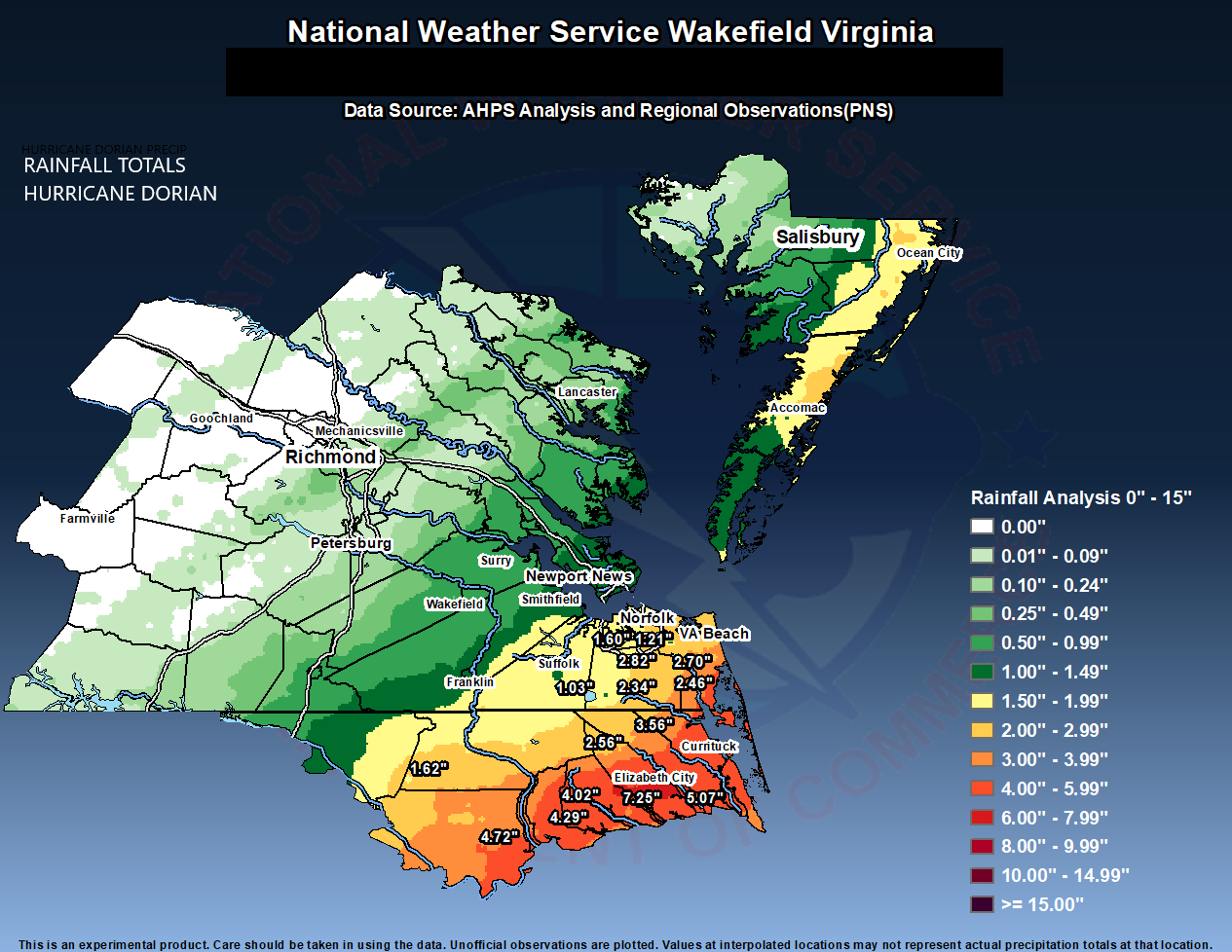 |
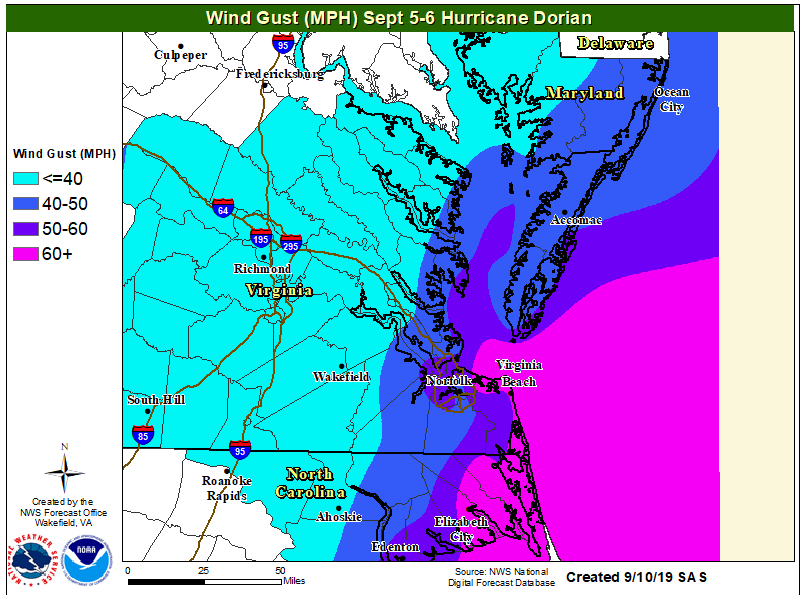 |
Tornadoes:
The Enhanced Fujita (EF) Scale classifies tornadoes into the following categories:
| EF0 Weak 65-85 mph |
EF1 Moderate 86-110 mph |
EF2 Significant 111-135 mph |
EF3 Severe 136-165 mph |
EF4 Extreme 166-200 mph |
EF5 Catastrophic 200+ mph |
 |
|||||
Wind Reports/Photos
Public Information Statement National Weather Service Wakefield VA 431 PM EDT Fri Sep 6 2019 ...HIGHEST WIND REPORTS... Location Speed Time/Date Lat/Lon Chesapeake Light Tower 83 MPH 1011 AM 09/06 36.90N/75.71W Cape Henry 70 MPH 1036 AM 09/06 36.93N/76.01W Cape Henry, VA 70 MPH 1054 AM 09/06 36.93N/76.01W Elizabeth City Airport 70 MPH 0744 AM 09/06 36.27N/76.18W Ccem Carova Beach Fire Depar 68 MPH 0750 AM 09/06 36.52N/75.87W Third Island 68 MPH 1034 AM 09/06 37.04N/76.08W 2 NNE Bayside 68 MPH 0746 AM 09/06 36.91N/76.12W Norfolk Intl Airport 64 MPH 1116 AM 09/06 36.90N/76.20W Rudee Inlet 64 MPH 0907 AM 09/06 36.83N/75.97W Sandbridge 64 MPH 0959 AM 09/06 36.70N/75.93W Corolla 63 MPH 1030 AM 09/06 36.30N/75.80W 3 NW Moyock 61 MPH 0939 AM 09/06 36.52N/76.18W Middle Ground Lighthouse 60 MPH 0851 AM 09/06 36.95N/76.39W Creeds 59 MPH 0805 AM 09/06 36.59N/76.02W Edenton 59 MPH 0820 AM 09/06 36.02N/76.57W Hertford 56 MPH 0745 AM 09/06 36.16N/76.32W Willoughby Deguassing Statio 56 MPH 0848 AM 09/06 36.98N/76.32W Fentress Naval 55 MPH 0934 AM 09/06 36.70N/76.13W Chapanoke 54 MPH 0640 AM 09/06 36.24N/76.36W Hampton Flats 54 MPH 0847 AM 09/06 36.98N/76.36W Oceana NAS Souce 54 MPH 1124 AM 09/06 36.82N/76.02W South Craney Island 53 MPH 0800 AM 09/06 36.89N/76.34W New Point Comfort 53 MPH 0940 AM 09/06 37.33N/76.27W 1 NW Cradock 52 MPH 1145 AM 09/06 36.80N/76.33W Poquoson 52 MPH 1116 AM 09/06 37.11N/76.32W Thimble Shoals 52 MPH 1149 AM 09/06 37.05N/76.26W York River East Rear Range L 52 MPH 1130 AM 09/06 37.25N/76.33W Rappahannock Light 51 MPH 1154 AM 09/06 37.54N/76.02W Suffolk 50 MPH 0901 AM 09/06 36.87N/76.50W Lafayette River 49 MPH 1015 AM 09/06 36.89N/76.32W Norfolk NAS Cham 49 MPH 0841 AM 09/06 36.92N/76.27W Tangier Sound Light 49 MPH 1216 PM 09/06 37.79N/75.97W Wachapreague, VA 49 MPH 1148 AM 09/06 37.61N/75.69W Hampton 48 MPH 0824 AM 09/06 37.08N/76.30W Kiptopeke, VA 48 MPH 1142 AM 09/06 37.17N/75.99W Poquoson River Light 47 MPH 0543 AM 09/06 37.16N/76.38W Plantation Flats 47 MPH 0749 AM 09/06 37.26N/76.03W Deltaville 46 MPH 0922 AM 09/06 37.56N/76.31W Ocean City 46 MPH 1119 AM 09/06 38.33N/75.08W Chesapeake 45 MPH 0815 AM 09/06 36.67N/76.32W Wallops Island 45 MPH 1209 PM 09/06 37.93N/75.47W Greens Cross 44 MPH 0817 AM 09/06 36.02N/76.89W Langley AFB Hamp 44 MPH 0933 AM 09/06 37.07N/76.37W Machipongo 44 MPH 0755 AM 09/06 37.41N/75.97W Assateague Island 43 MPH 1140 AM 09/06 38.08N/75.20W Tangier Island 43 MPH 1101 AM 09/06 37.82N/75.98W 2 WSW Kenbridge 38 MPH 0521 PM 09/05 36.95N/78.17W Ahoskie Tri Coun 36 MPH 0935 AM 09/06 36.28N/77.17W Lewisetta, VA 36 MPH 1142 AM 09/06 38.00N/76.46W Emporia 35 MPH 0835 AM 09/06 36.68N/77.48W Toano 29 MPH 1150 AM 09/06 37.44N/76.82W &&
Selected Wind/Wind Damage Photos
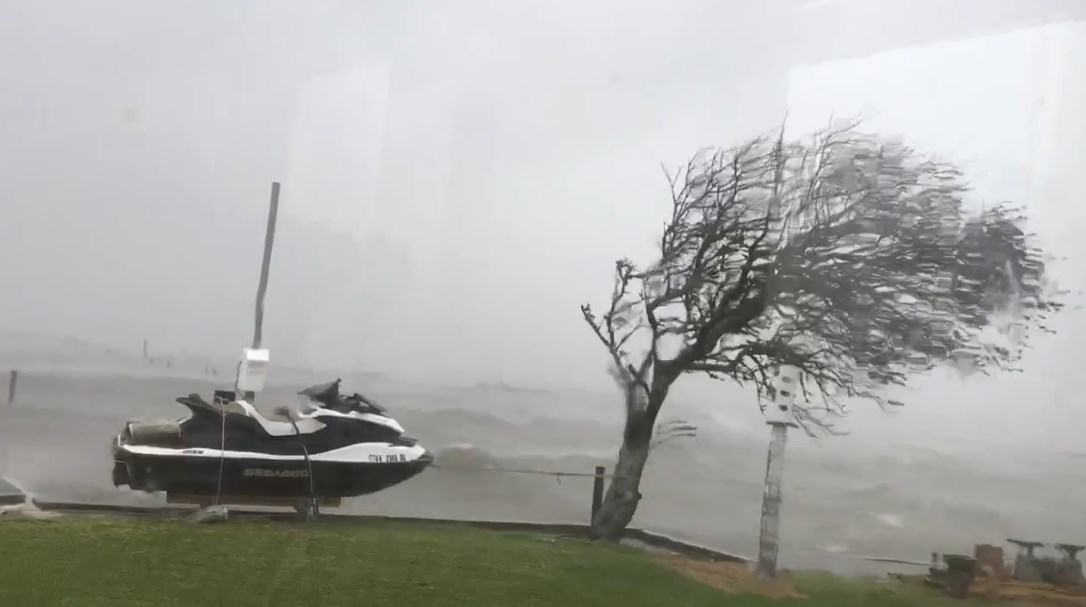 |
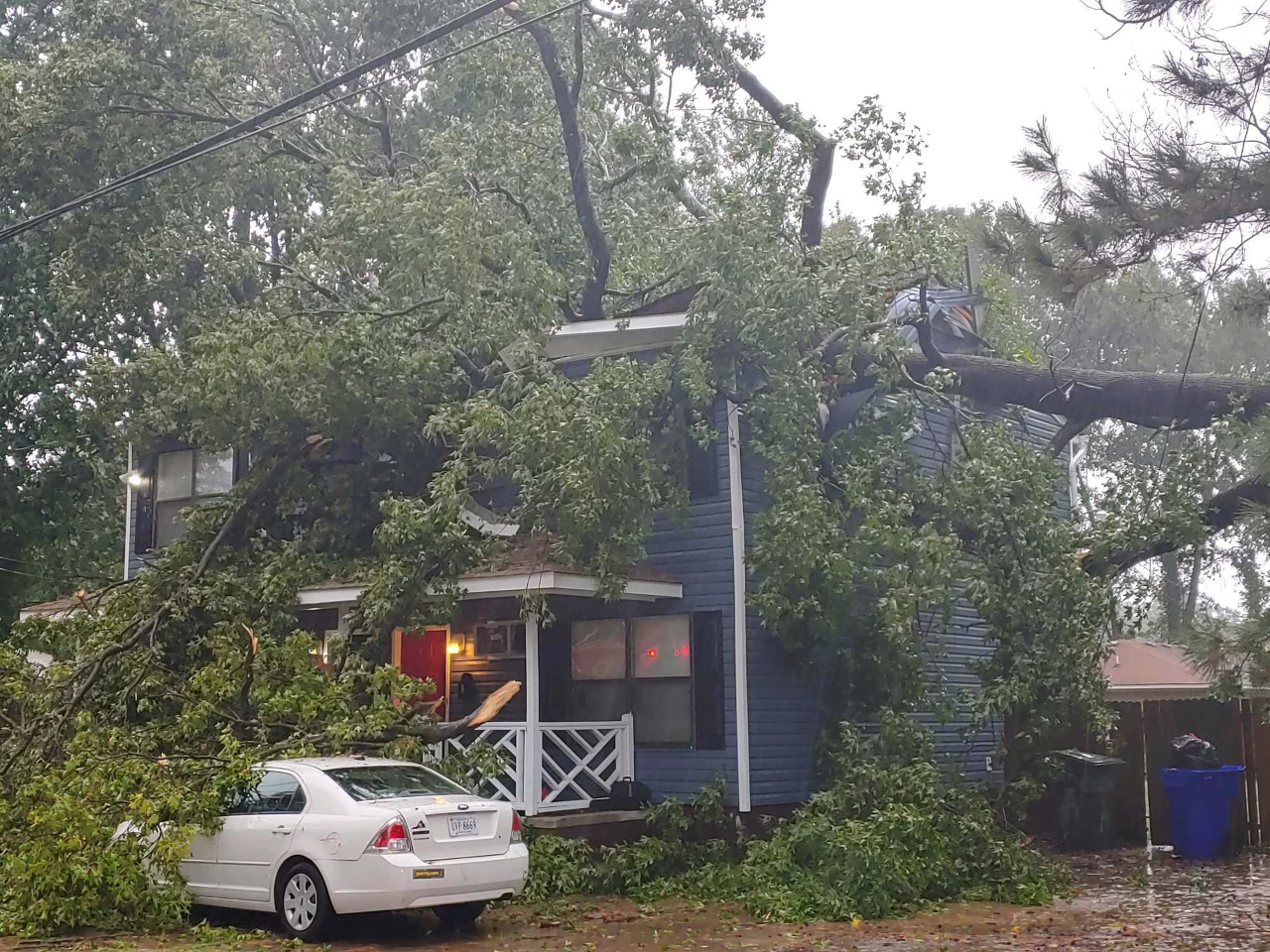 |
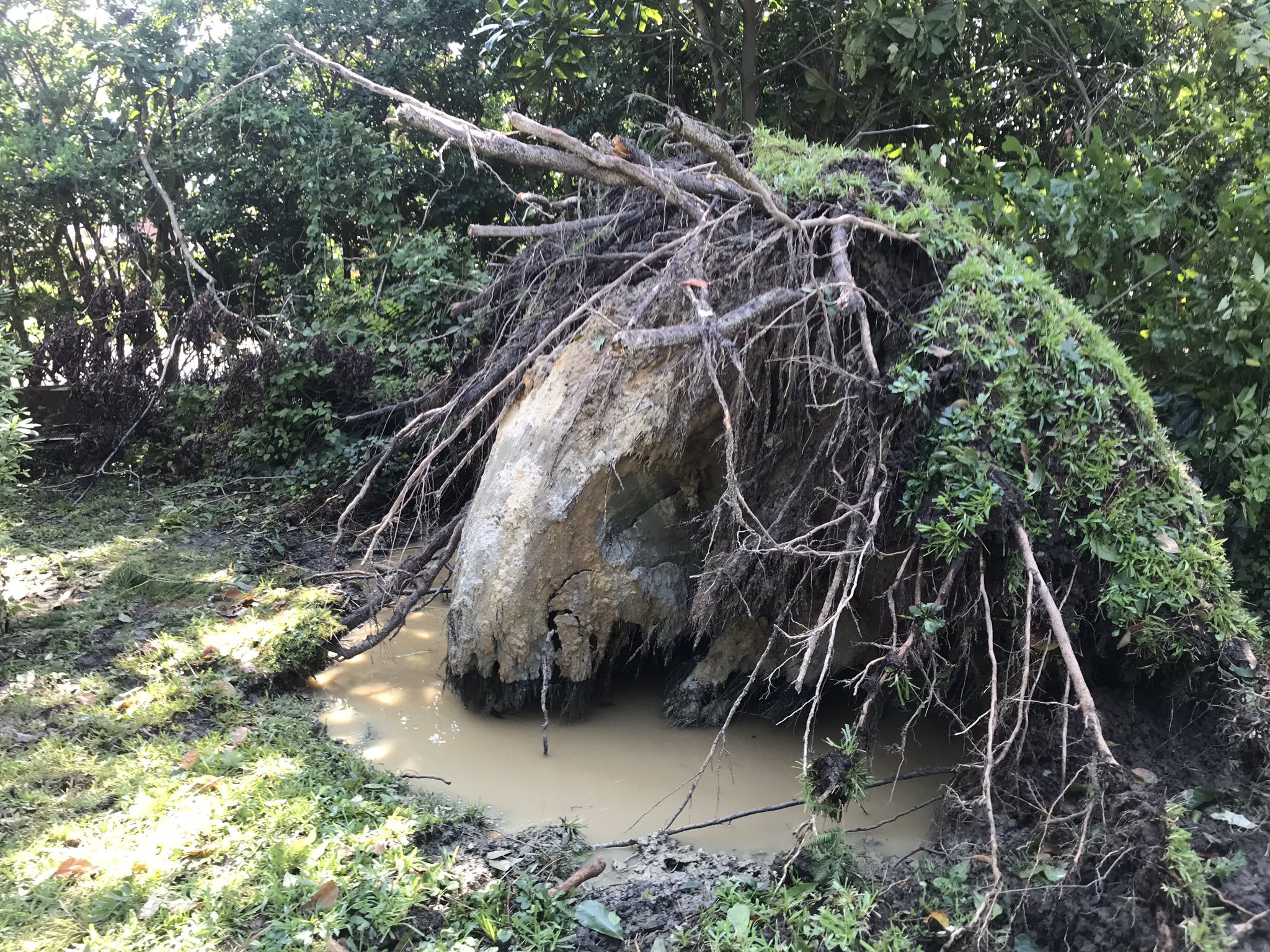 |
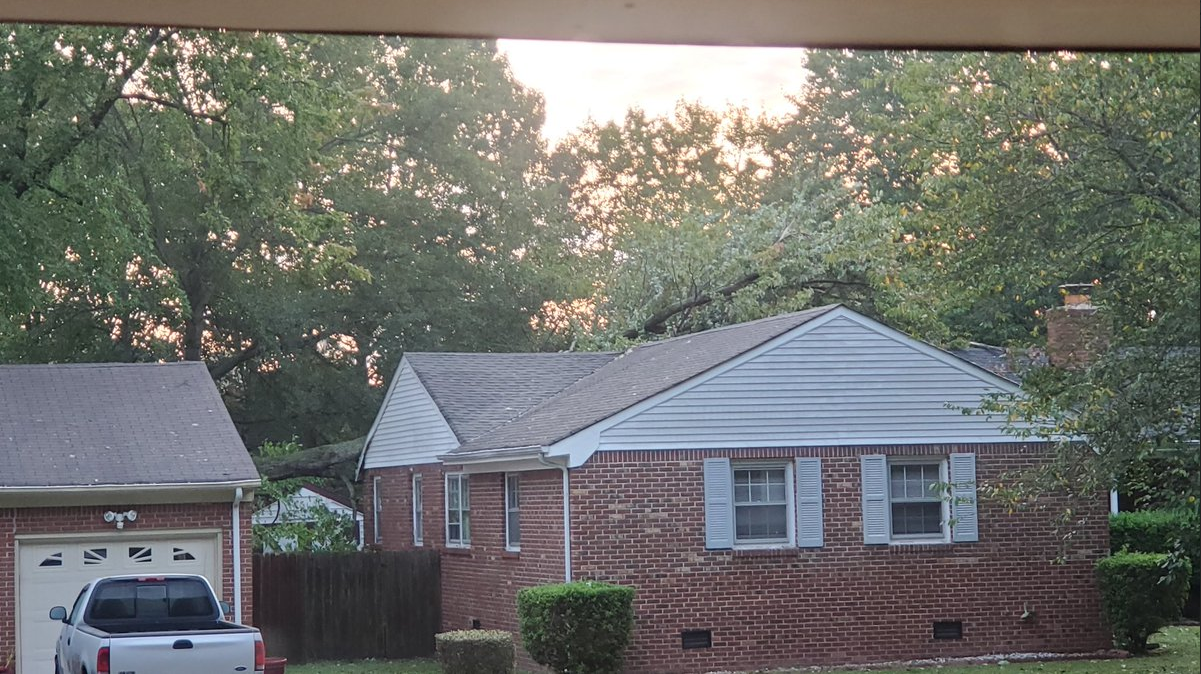 |
| Currituck Sound from Waterlilly, NC (Credit: WAVY-TV) | Tree Down on House in Norfolk (Credit: WAVY-TV) | Large Tree Uprooted in Elizabeth City (Credit: 13 News Now) | Tree Down on House in VA Beach (Credit: Jeffrey Adams) |
Selected Flooding Photos
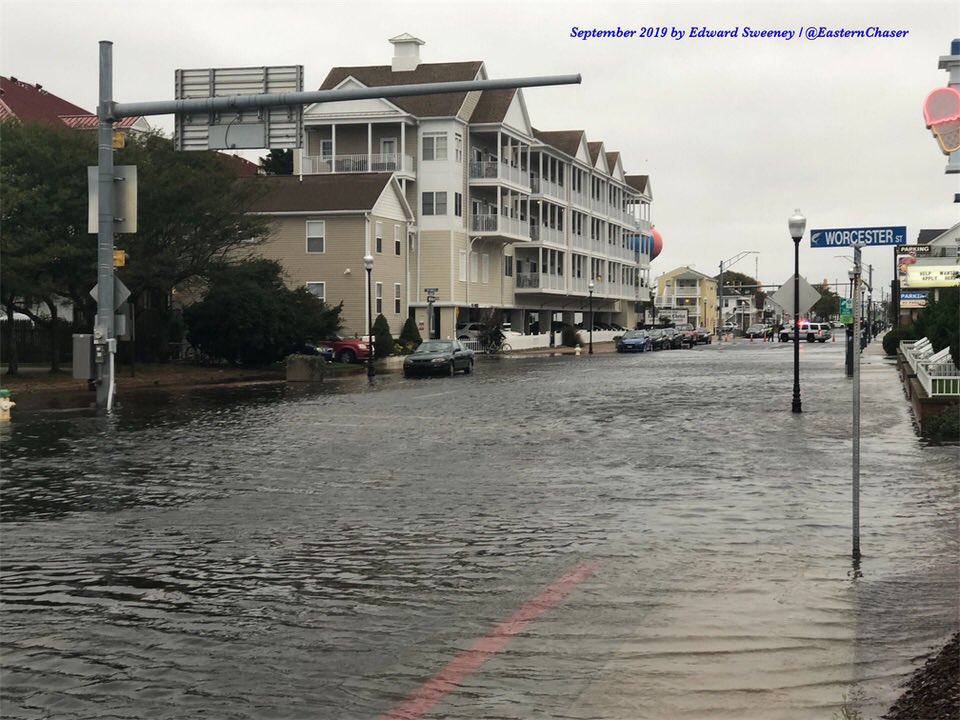 |
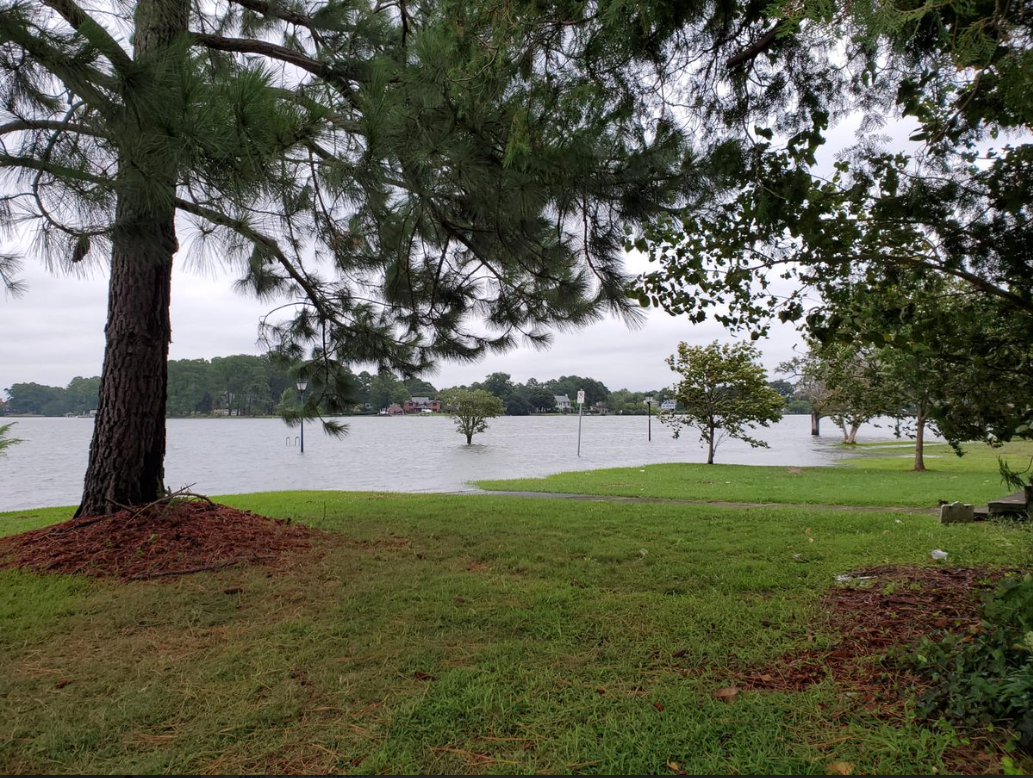 |
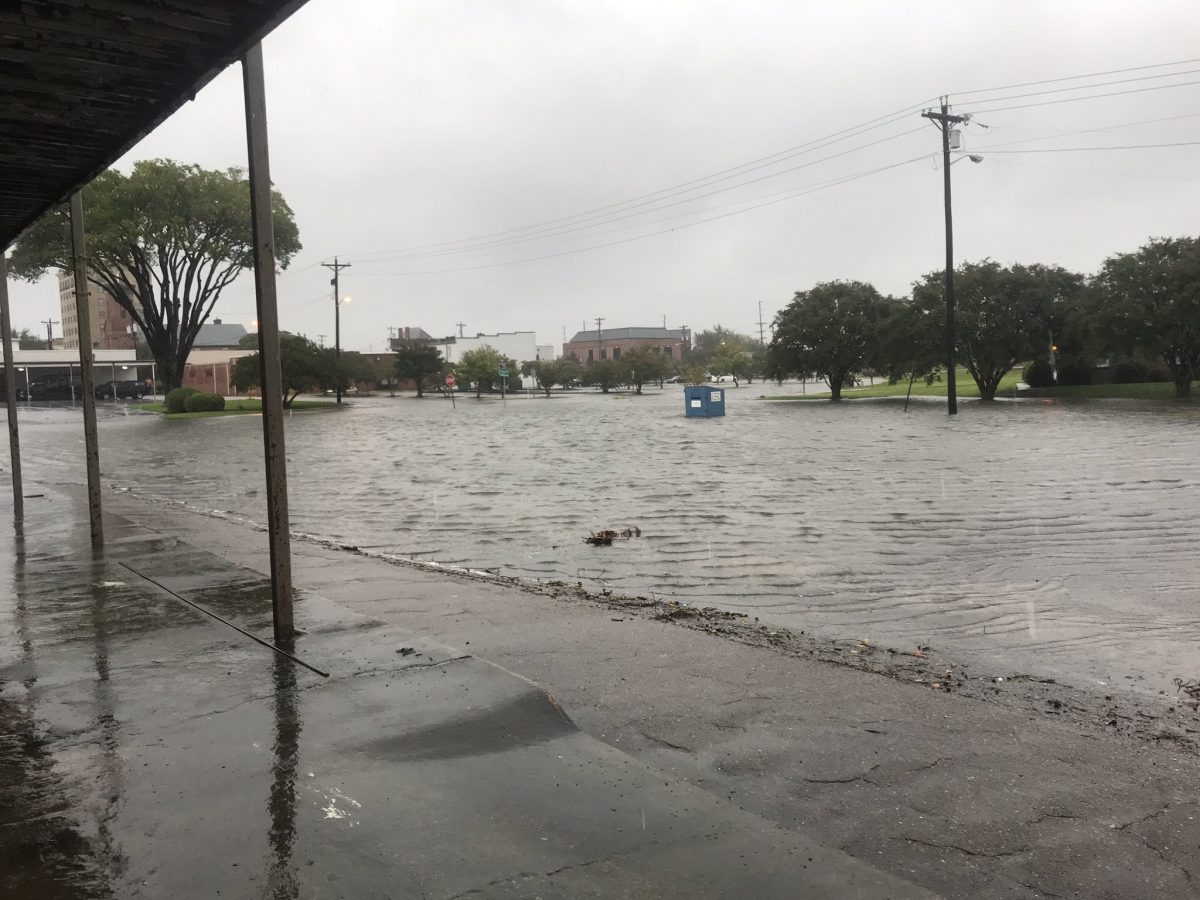 |
| Coastal Flooding in Ocean City, MD | Flooding in Colonial Place | Coastal Flooding in Elizabeth City |
Radar
Radar Loop and Selected Images
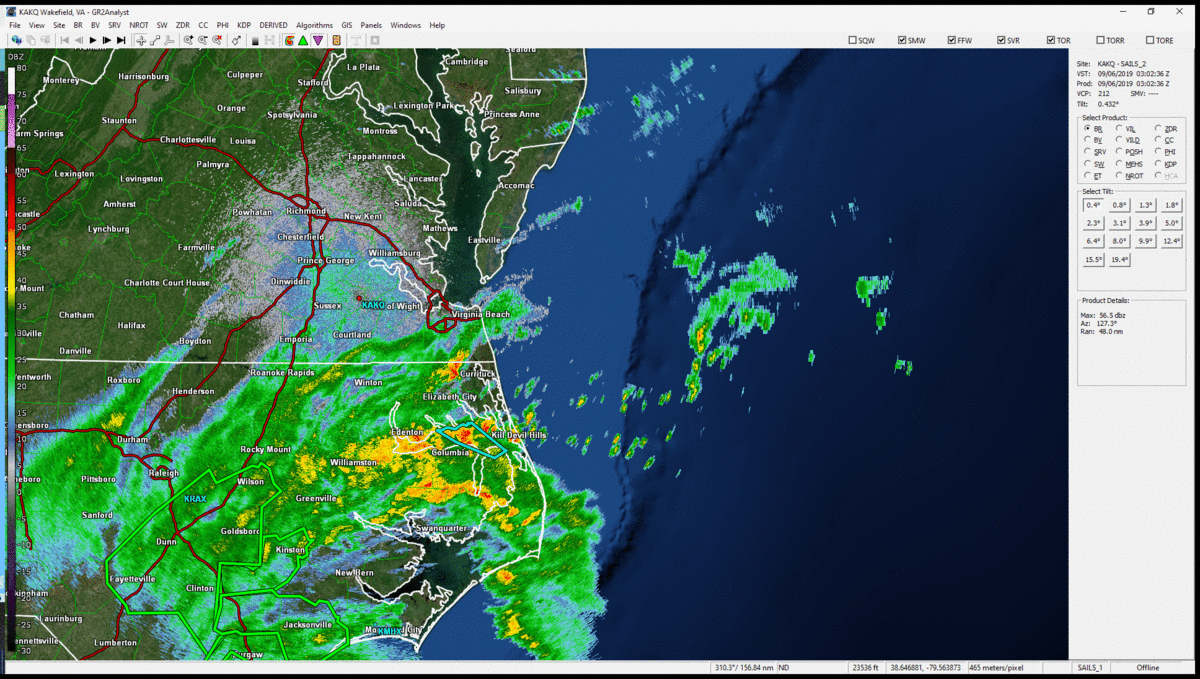 |
| Radar Loop of Hurricane Dorian with Warnings (from AKQ Radar) . Times are from 11 PM (9/5) to 3 PM (9/6) in ~30 minute increments. |
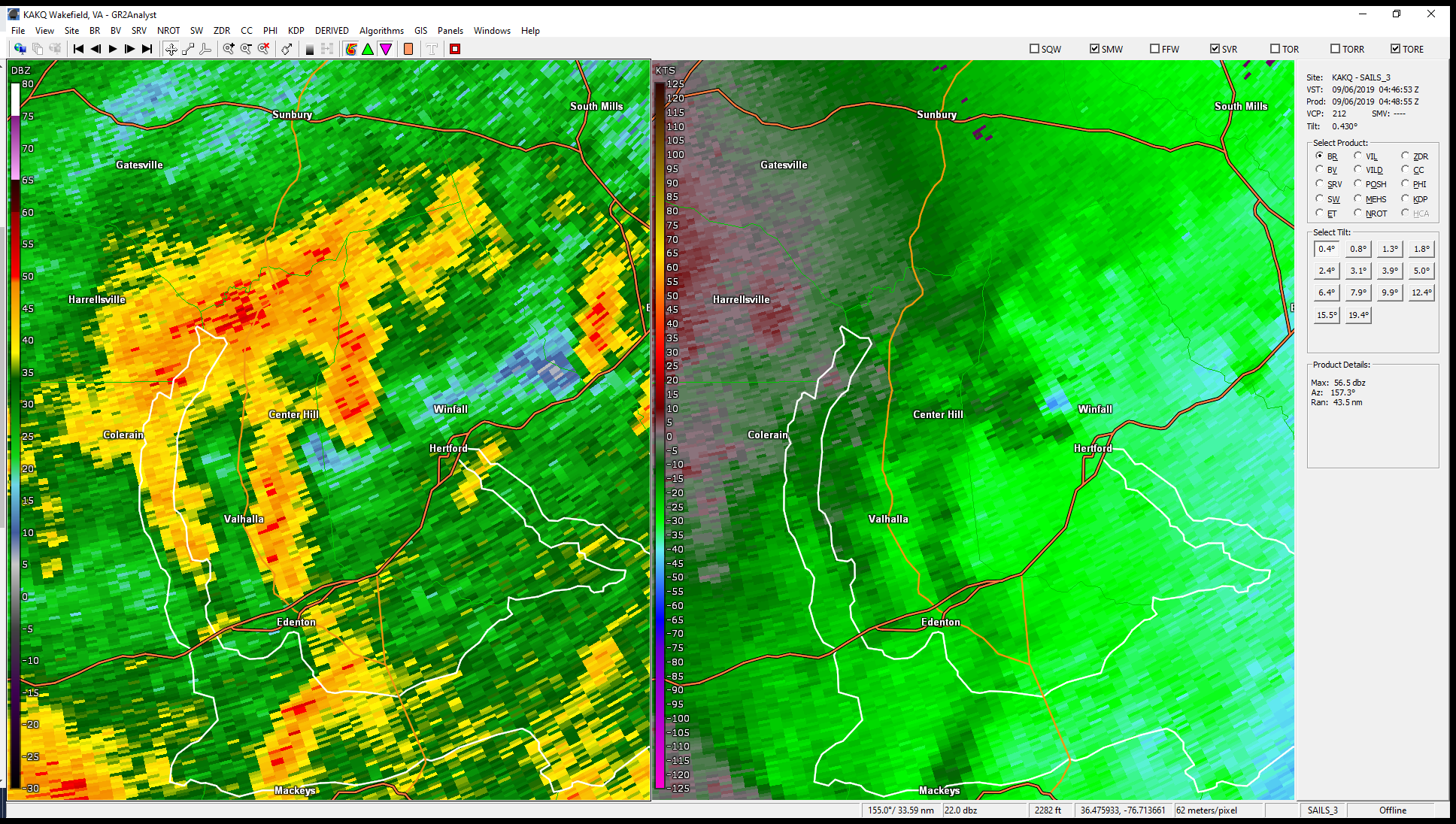 |
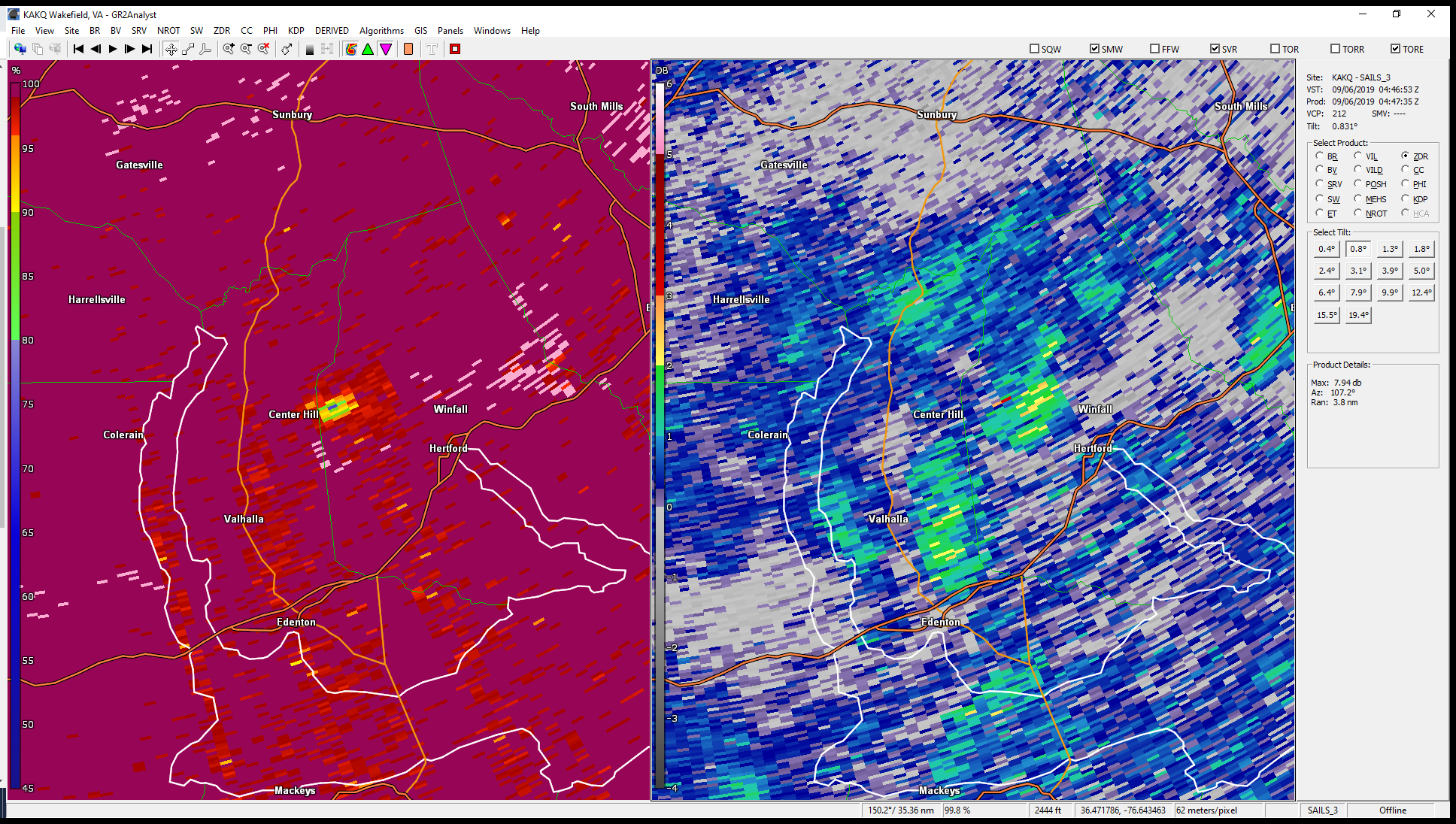 |
| 0.5° Reflectivity (left) and SRM (right) from just after the time of the Perquimans County tornado. | 0.5° Correlation Coefficient (left) and ZDR (right) from the same time as the corresponding Reflectivity/Velocity images that are shown to the left. Note the area of lower CC showing a possible tornado debris signature. |
Storm Reports
..TIME... ...EVENT... ...CITY LOCATION... ...LAT.LON...
..DATE... ....MAG.... ..COUNTY LOCATION..ST.. ...SOURCE....
..REMARKS..
0800 AM FLASH FLOOD 1 ESE ELIZABETH CITY 36.29N 76.21W
09/06/2019 PASQUOTANK NC BROADCAST MEDIA
FLORA STREET IMPASSABLE DUE TO FLOODING.
0800 AM NON-TSTM WND DMG ELIZABETH CITY 36.30N 76.22W
09/06/2019 PASQUOTANK NC BROADCAST MEDIA
TREES UPROOTED AND POWERLINES DOWN IN
ELIZABETH CITY.
0901 AM NON-TSTM WND DMG CURRITUCK 36.45N 76.02W
09/06/2019 CURRITUCK NC PUBLIC
SEVERAL TREES AND POWERLINES DOWN DUE TO
HIGH WINDS.
0855 AM NON-TSTM WND DMG SIGMA 36.73N 75.98W
09/06/2019 CITY OF VIRGINIA BEVA BROADCAST MEDIA
TREE DOWN ON SANDBRIDGE ROAD JUST OUTSIDE OF
VIRGINIA BEACH.
0911 AM FLASH FLOOD ELIZABETH CITY 36.30N 76.22W
09/06/2019 PASQUOTANK NC PUBLIC
STREET/ROAD FLOODING; STREET/ROAD CLOSED;
VEHICLES STRANDED.
1045 AM FLASH FLOOD 1 NW WINFALL 36.22N 76.46W
09/06/2019 PERQUIMANS NC DEPT OF HIGHWAYS
NC DOT REPORTED THAT FOWLER FORT ROAD IS
CLOSED DUE TO FLOODING.
1151 AM COASTAL FLOOD CURRITUCK 36.45N 76.02W
09/06/2019 CURRITUCK NC TRAINED SPOTTER
ACCESS ON ROUTE 168 TO THE OUTER BANKS CUT
OFF AT HIGH TIDE.
1200 PM FLASH FLOOD 1 SSE ELIZABETH CITY 36.28N 76.21W
09/06/2019 PASQUOTANK NC LAW ENFORCEMENT
FLASH FLOODING REPORTED ON SEVERAL CAMPUS
STREETS AT ELIZABETH CITY STATE UNIVERSITY.
IN ADDITION, SEVERAL BUILDINGS HAVE WATER IN
INTERIOR ENTRANCES.
1240 PM NON-TSTM WND DMG 4 NW MUNDEN 36.61N 76.08W
09/06/2019 CITY OF VIRGINIA BEVA PUBLIC
TREE LIMBS BROKEN; SHINGLES BLOWN OFF.
0900 AM TROPICAL STORM NORVIEW 36.89N 76.25W
09/06/2019 CITY OF NORFOLK VA FIRE DEPT/RESCUE
LARGE TREE FELL ON HOUSE REPORTED AT NORVIEW
NORFOLK, VA.
1230 PM HURRICANE KNOTTS ISLAND 36.52N 75.93W
09/06/2019 CURRITUCK NC PUBLIC
POWER LINES DOWN, POWER POLES SNAPPED,
MULTIPLE TREES DOWN.
1256 PM HURRICANE 3 SE MUNDEN 36.54N 76.00W
09/06/2019 CURRITUCK NC PUBLIC
SHINGLES BLOWN OFF.
1050 AM TROPICAL STORM 3 S NORFOLK INTERNATION 36.86N 76.21W
09/06/2019 CITY OF NORFOLK VA PUBLIC
POWER POLES BROKEN.
1158 AM TROPICAL STORM 2 W NORTHWEST 36.57N 76.23W
09/06/2019 CITY OF CHESAPEAKE VA PUBLIC
SHINGLES BLOWN OFF.
1205 PM TROPICAL STORM 5 W NORTHWEST 36.60N 76.28W
09/06/2019 CITY OF CHESAPEAKE VA PUBLIC
POWER POLES BROKEN.
1230 PM TROPICAL STORM 4 SE FENTRESS 36.66N 76.15W
09/06/2019 CITY OF CHESAPEAKE VA PUBLIC
POWER POLES BROKEN.
1250 PM TROPICAL STORM MUNDEN 36.58N 76.02W
09/06/2019 CITY OF VIRGINIA BEVA PUBLIC
TREES UPROOTED OR SNAPPED; ROOF BLOWN OFF.
1254 PM TROPICAL STORM 2 SE MUNDEN 36.56N 76.01W
09/06/2019 CITY OF VIRGINIA BEVA PUBLIC
3-INCH TREE LIMBS BROKEN; POWER POLES
BROKEN.
0305 PM COASTAL FLOOD 2 S CHINCOTEAGUE 37.92N 75.35W
09/06/2019 ACCOMACK VA PUBLIC
STREET/ROAD FLOODING; STREET/ROAD CLOSED;
VEHICLES STRANDED.
0153 PM TROPICAL STORM 1 W HALLWOOD 37.07N 76.32W
09/06/2019 CITY OF HAMPTON VA PUBLIC
WIND GUST TO 55 MPH.
0325 PM STORM SURGE 2 N GHENT 36.90N 76.30W
09/06/2019 CITY OF NORFOLK VA PUBLIC
STREET/ROAD FLOODING; STREET/ROAD CLOSED;
VEHICLES STRANDED.
0240 PM STORM SURGE 1 W RESCUE 36.99N 76.56W
09/06/2019 ISLE OF WIGHT VA PUBLIC
STREET/ROAD FLOODING; STREET/ROAD CLOSED;
VEHICLES STRANDED.
0324 PM TROPICAL STORM 2 N GHENT 36.90N 76.30W
09/06/2019 CITY OF NORFOLK VA PUBLIC
3-INCH TREE LIMBS BROKEN; POWER POLES
BROKEN.
0220 PM TROPICAL STORM BAYSIDE 36.90N 76.14W
09/06/2019 CITY OF VIRGINIA BEVA PUBLIC
3-INCH TREE LIMBS BROKEN; POWER POLES
BROKEN.
1238 AM TORNADO 3 SW PARKVILLE 36.27N 76.44W
09/06/2019 PERQUIMANS NC EMERGENCY MNGR
A WEAK TORNADO TRACKED THROUGH FARMLAND
LEAVING A WELL DEFINED TRACK IN THE FIELD
NEAR FOUR MILE DESERT RD.
Rainfall Reports
Public Information Statement National Weather Service Wakefield VA 1151 AM EDT Fri Sep 6 2019 ...PRECIPITATION REPORTS... Location Amount Time/Date Lat/Lon Mariner`S Warf Park 7.33 in 1100 AM 09/06 36.30N/76.22W Chapanoke 7.25 in 0715 AM 09/06 36.24N/76.36W Elizabeth City Airport 6.99 in 1139 AM 09/06 36.27N/76.18W Shiloh 5.07 in 1115 AM 09/06 36.26N/76.10W Greens Cross 4.72 in 1117 AM 09/06 36.02N/76.89W Hertford 4.29 in 1121 AM 09/06 36.18N/76.47W Hertford 4.02 in 0956 AM 09/06 36.18N/76.47W South Mills 3.56 in 1123 AM 09/06 36.45N/76.30W Hertford 3.41 in 1115 AM 09/06 36.16N/76.32W Virginia Beach 2.89 in 1125 AM 09/06 36.77N/76.04W Greenbrier 2.82 in 1139 AM 09/06 36.79N/76.22W Virginia Beach 2.70 in 1125 AM 09/06 36.78N/76.14W Joyce Creek Intracoastal Wat 2.56 in 1000 AM 09/06 36.44N/76.33W Fentress Naval 2.46 in 1132 AM 09/06 36.70N/76.13W Virginia Beach 2.46 in 1125 AM 09/06 36.75N/75.99W Chesapeake 2.34 in 1116 AM 09/06 36.69N/76.21W Oceana NAS Souce 2.29 in 1139 AM 09/06 36.82N/76.02W Ahoskie Tri Coun 1.62 in 1135 AM 09/06 36.28N/77.17W Ghent 1.60 in 1139 AM 09/06 36.86N/76.30W 1 SSE Kempsville 1.21 in 1139 AM 09/06 36.81N/76.16W Suffolk 1.03 in 1135 AM 09/06 36.68N/76.60W &&
Tidal Flooding
Here are 11 hydrographs from selected locations in the AKQ Forecast Area, with one (Duck, NC) just outside the forecast area.
***ALL WATER LEVELS ARE REFERENCD TO MEAN LOWER LOW WATER (MLLW).
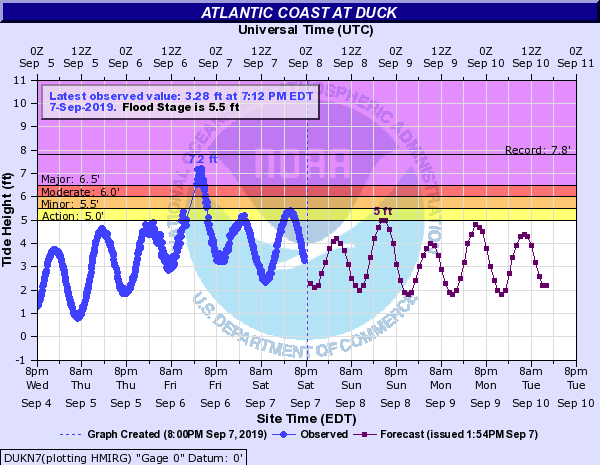 |
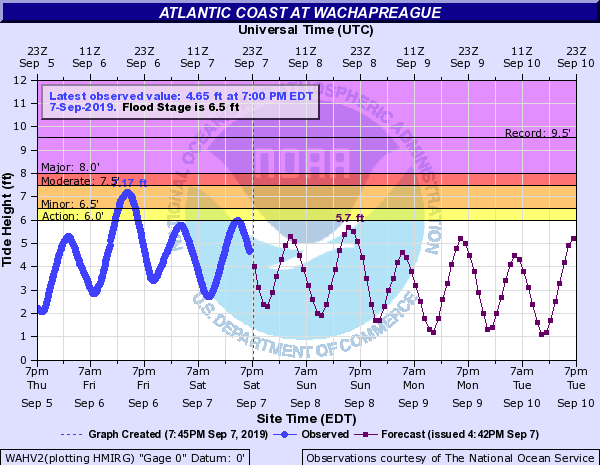 |
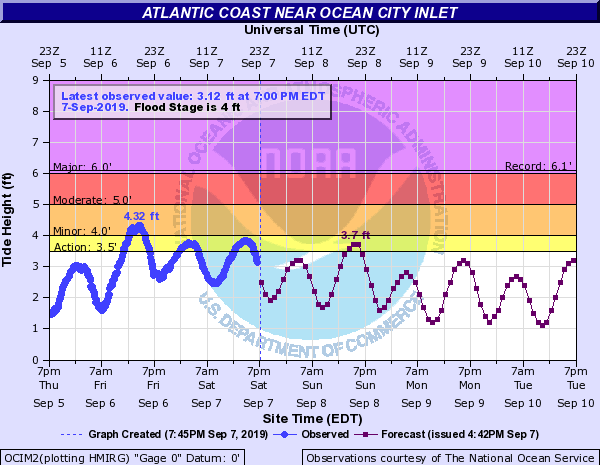 |
| Duck, NC | Wachapreague, VA | Ocean City, MD |
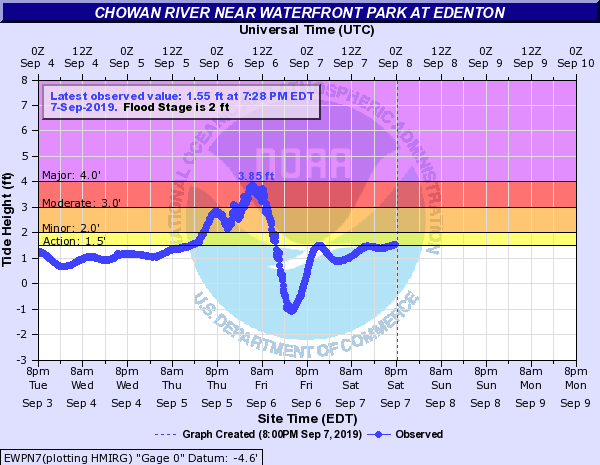 |
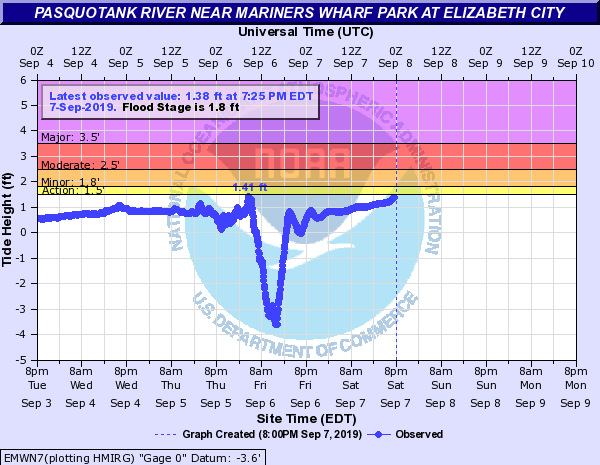 |
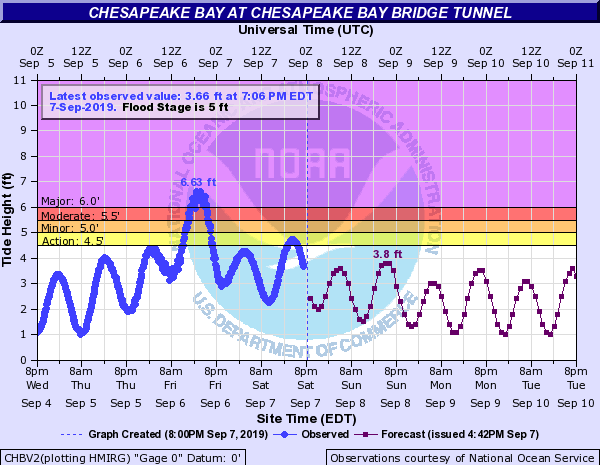 |
| Edenton, NC (Chowan River) | Elizabeth City, NC (Pasquotank River) | Chesapeake Bay Bridge Tunnel |
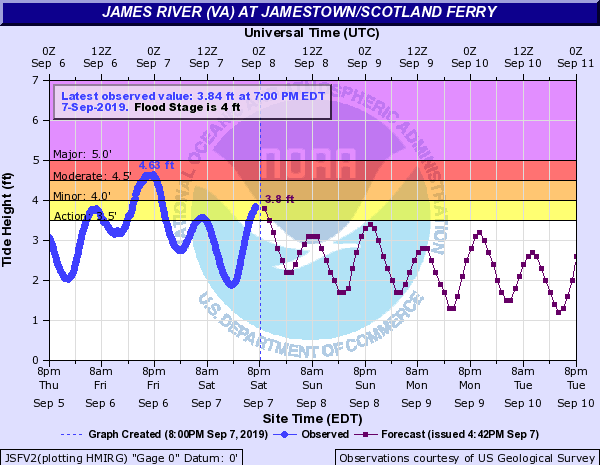 |
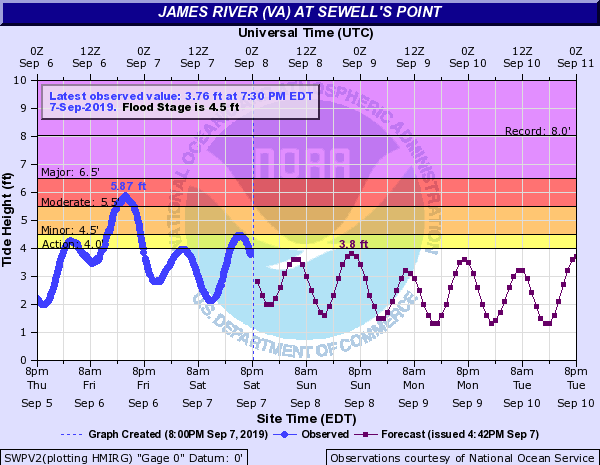 |
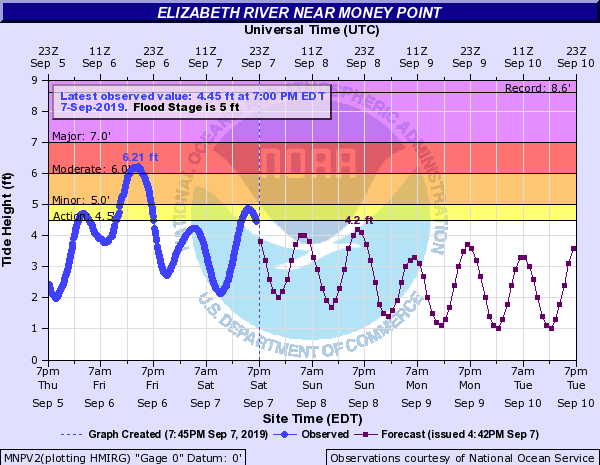 |
| Jamestown, VA (Upper James River) | Sewell's Point, VA (Lower James River) | Money Point, VA (Elizabeth River) |
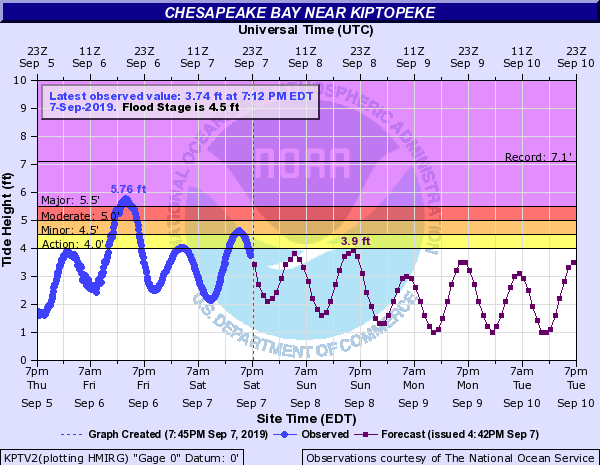 |
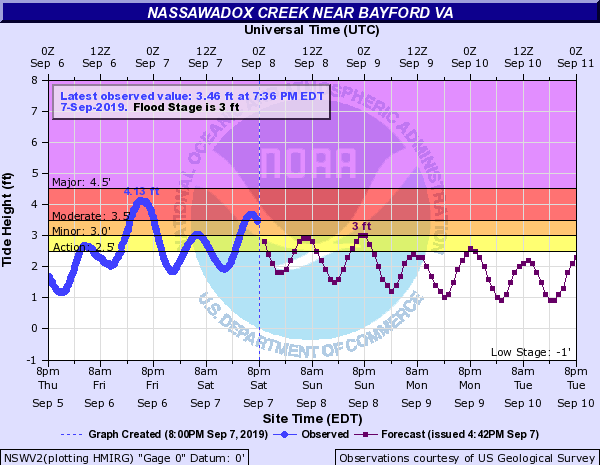 |
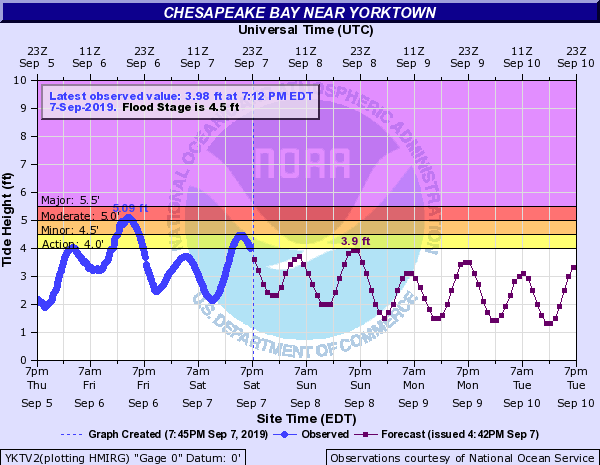 |
| Kiptopeke, VA (Southern Northampton County) | Bayford,VA (Northern Northampton County) | Yorktown, VA (Western Chesapeake Bay) |
Environment
Upper level synoptic summary.
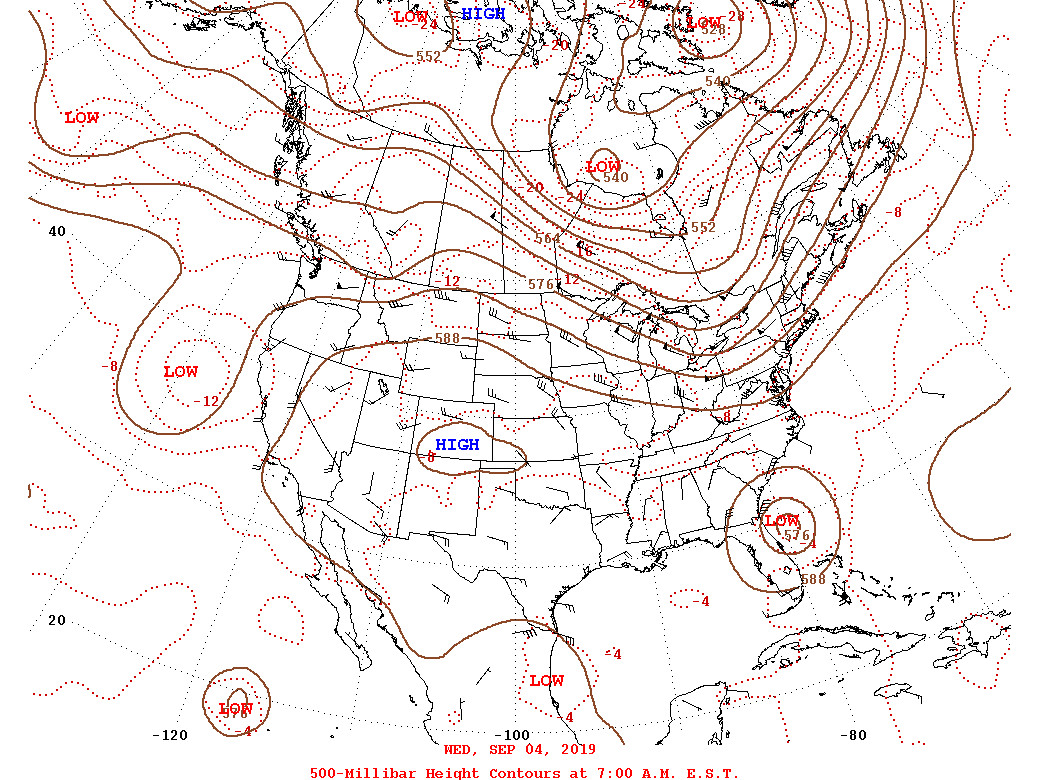 |
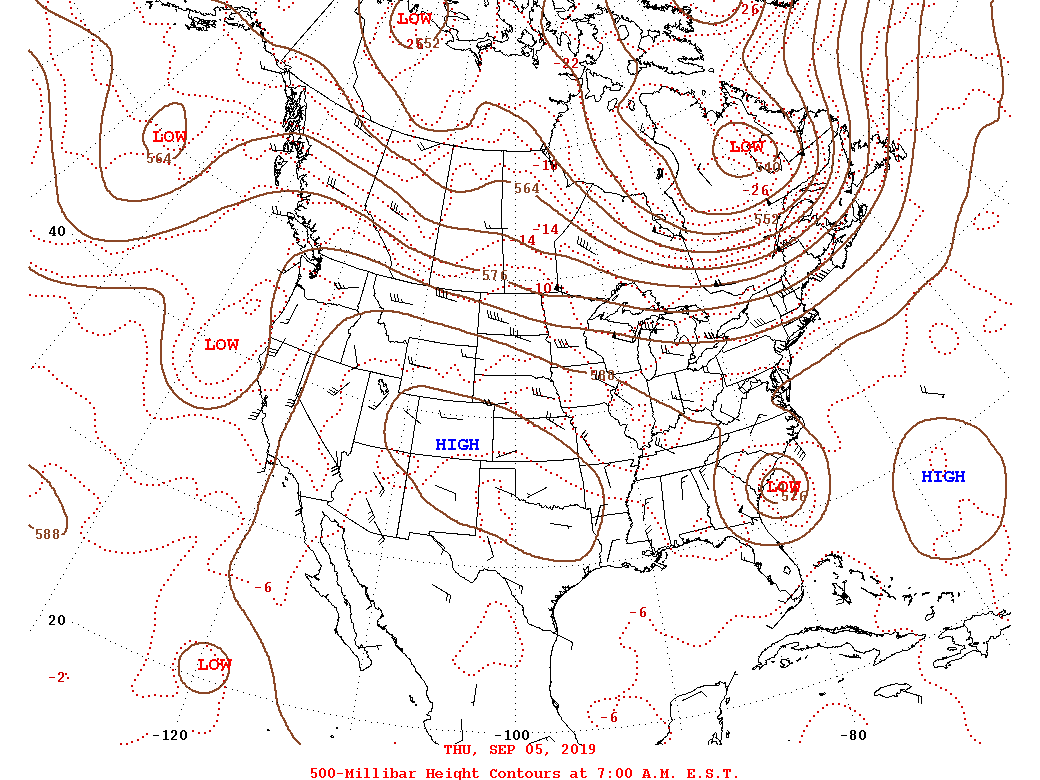 |
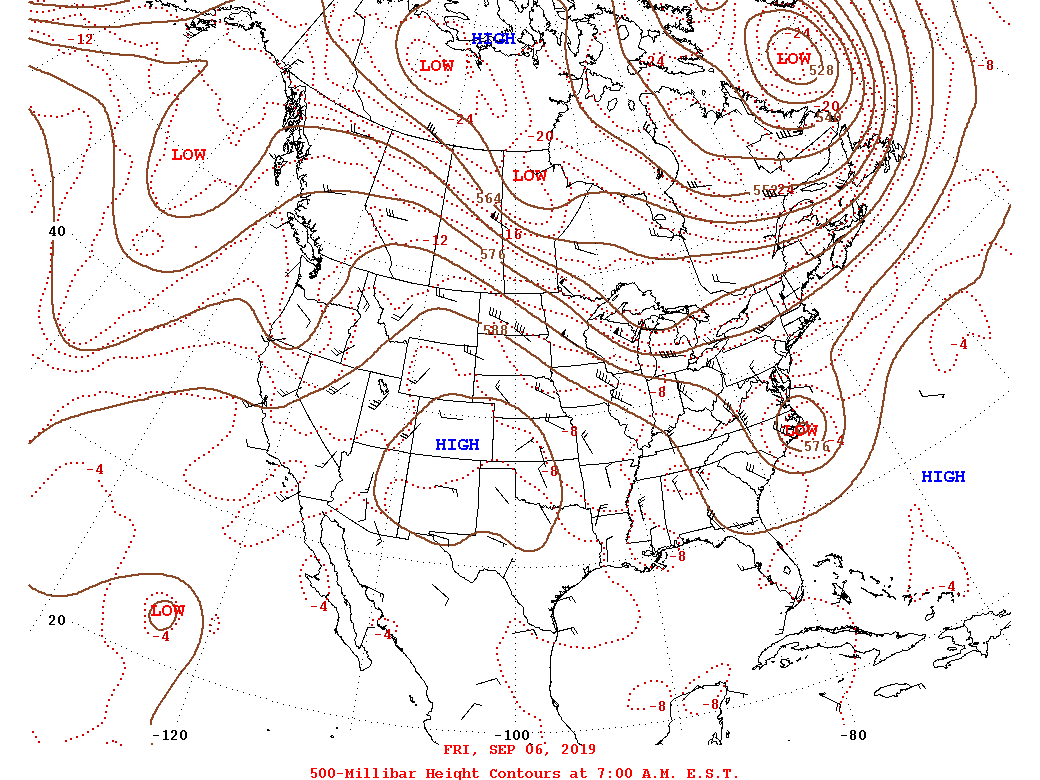 |
| 9/4 - 12z/8 AM 500mb Analysis | 9/5 - 12z/8 AM 500mb Analysis | 9/6 - 8 AM 500mb Analysis |
Surface synoptic summary.
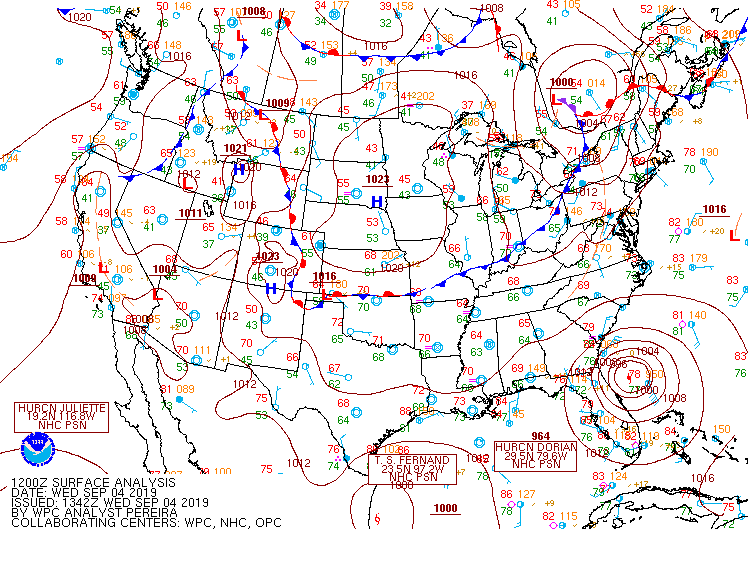 |
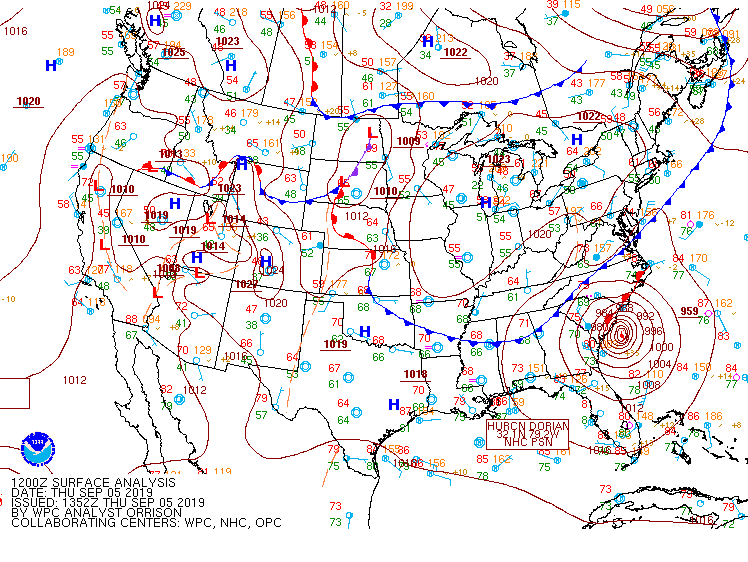 |
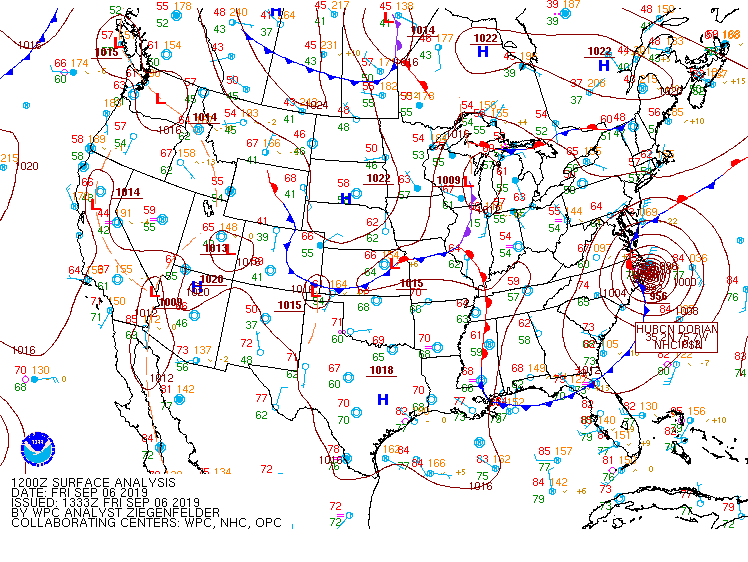 |
| 9/4 - 12z/8 AM WPC Surface Analysis | 9/5 - 12z/8 AM WPC Surface Analysis | 9/6 - 12z/8 AM WPC Surface Analysis |
Regional Surface Analysis/Observations
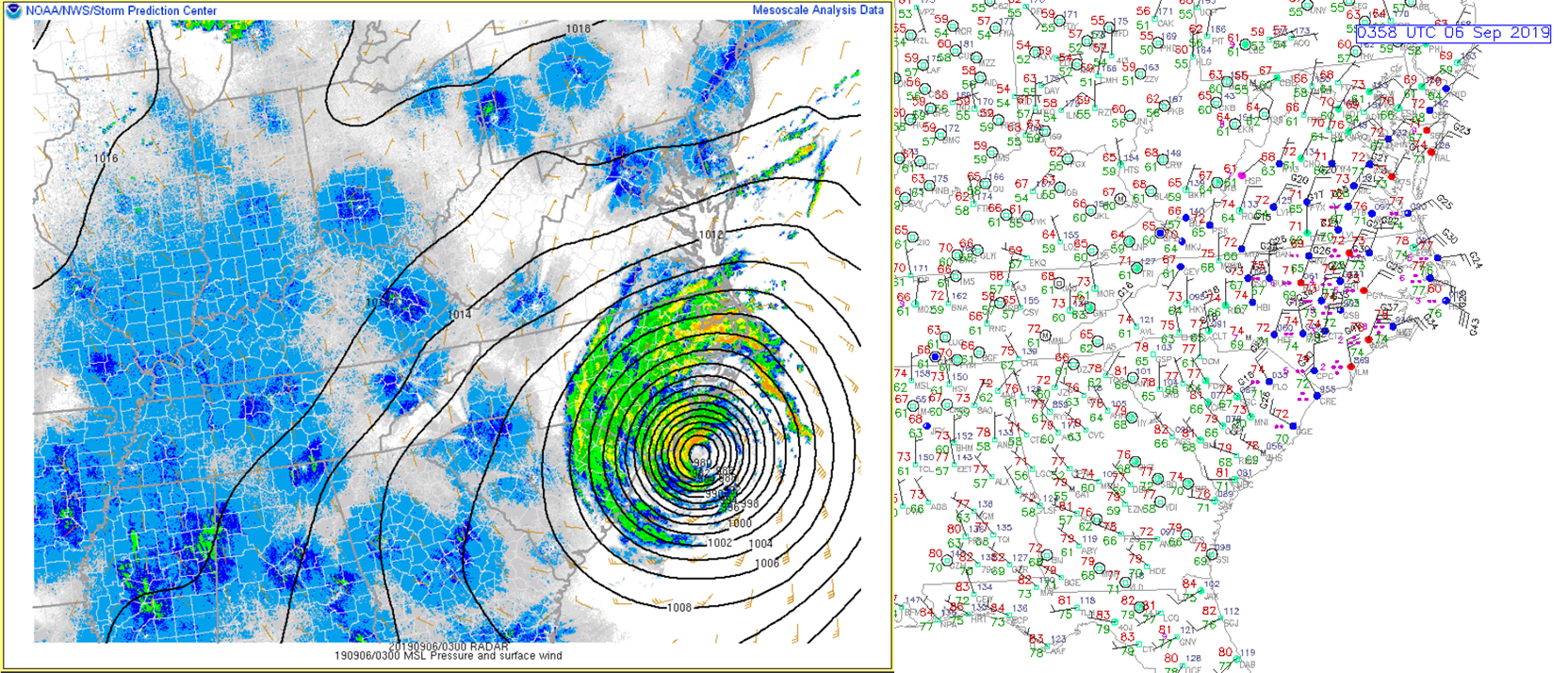 |
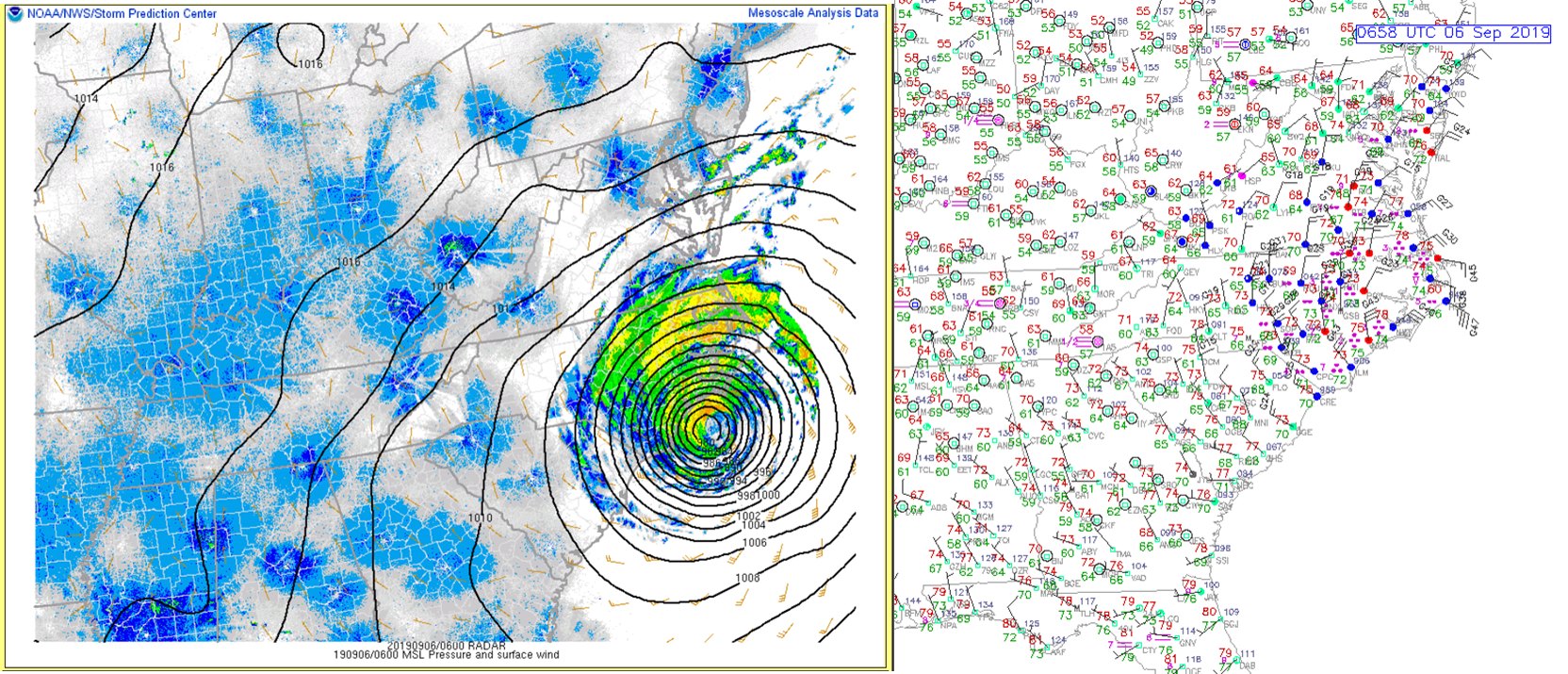 |
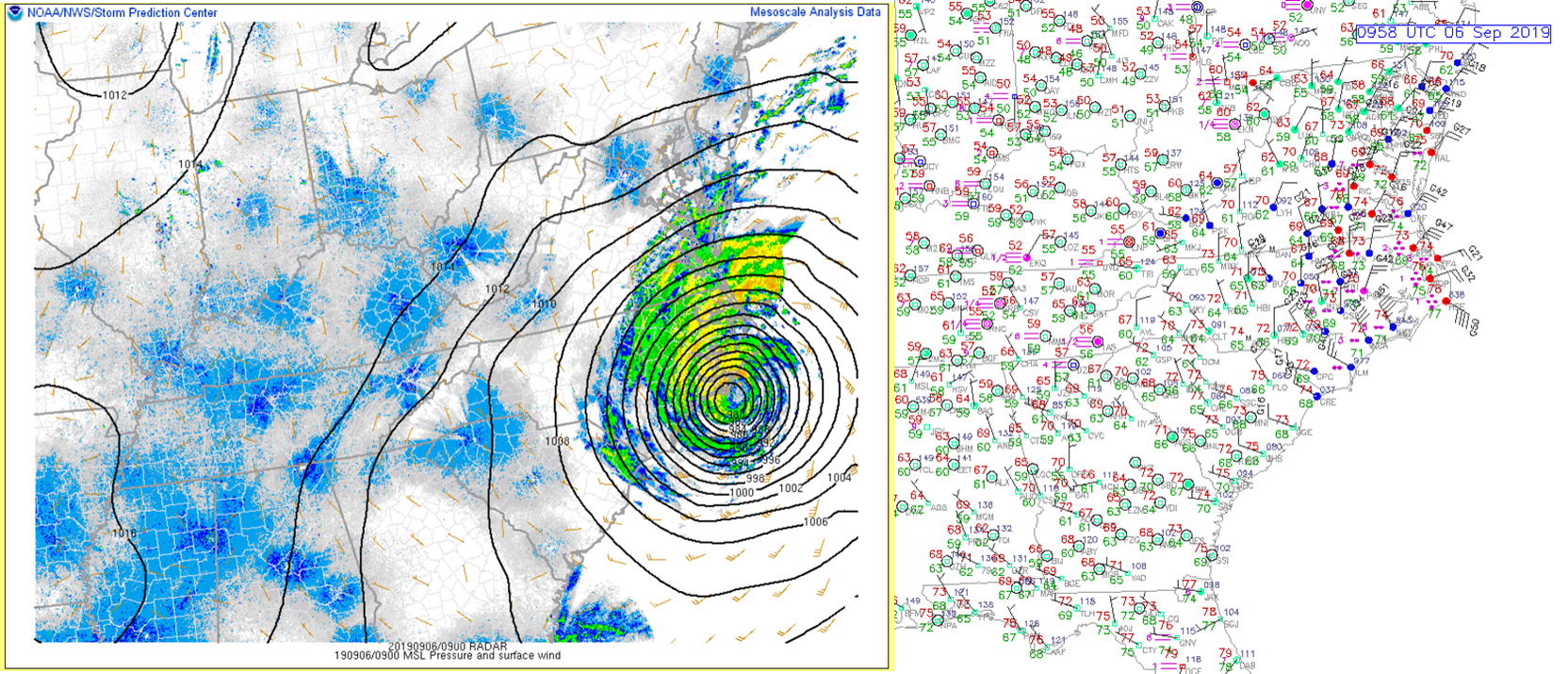 |
| 03z/11 PM (9/5) Regional Surface Analysis | 06z/2 AM Regional Surface Analysis | 09z/5 AM Regional Surface Analysis |
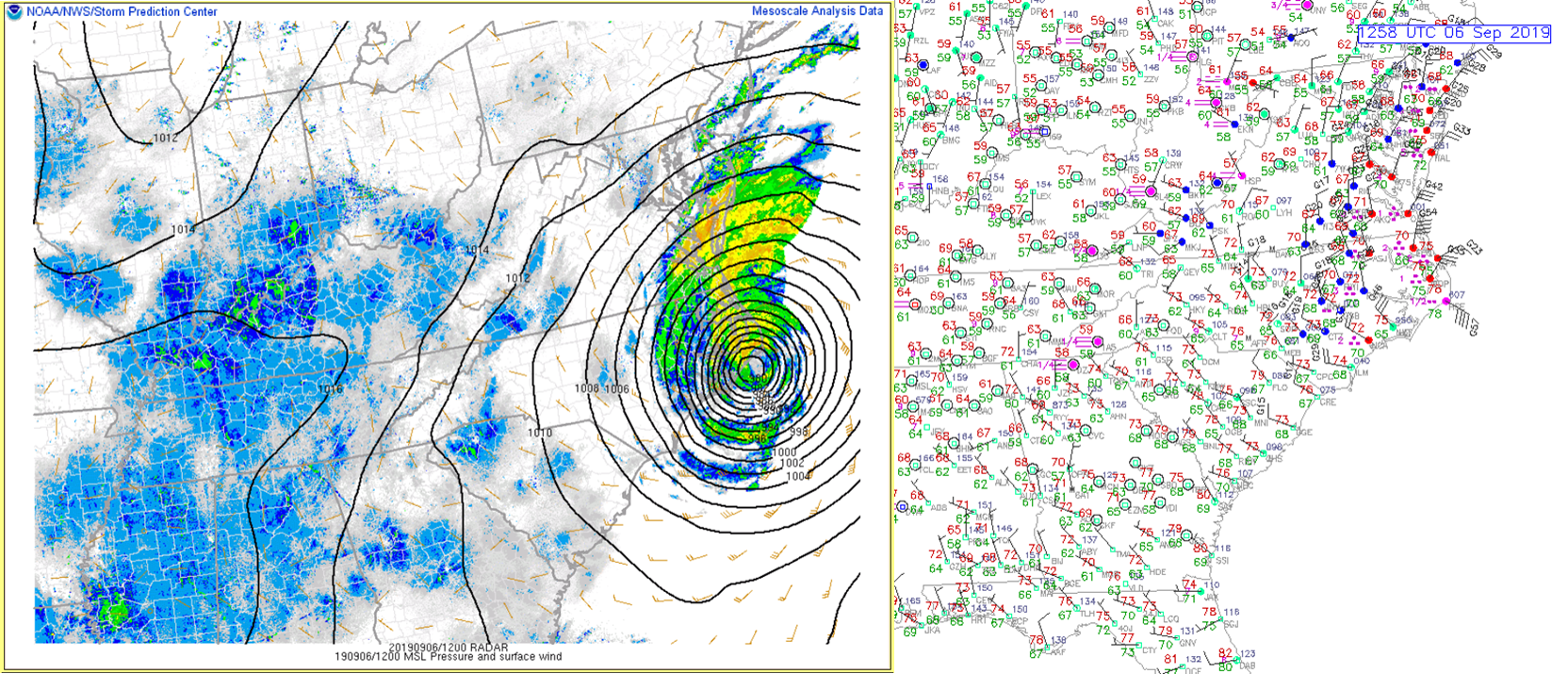 |
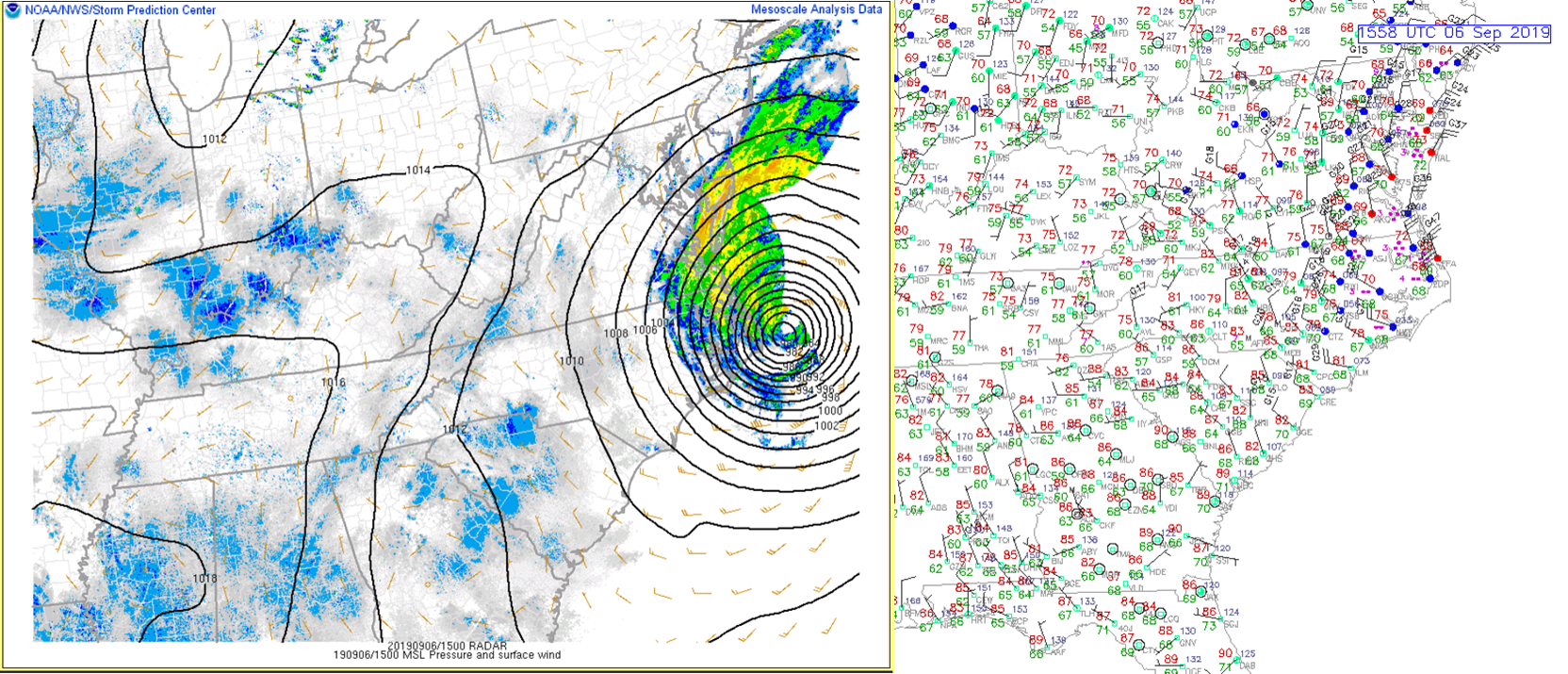 |
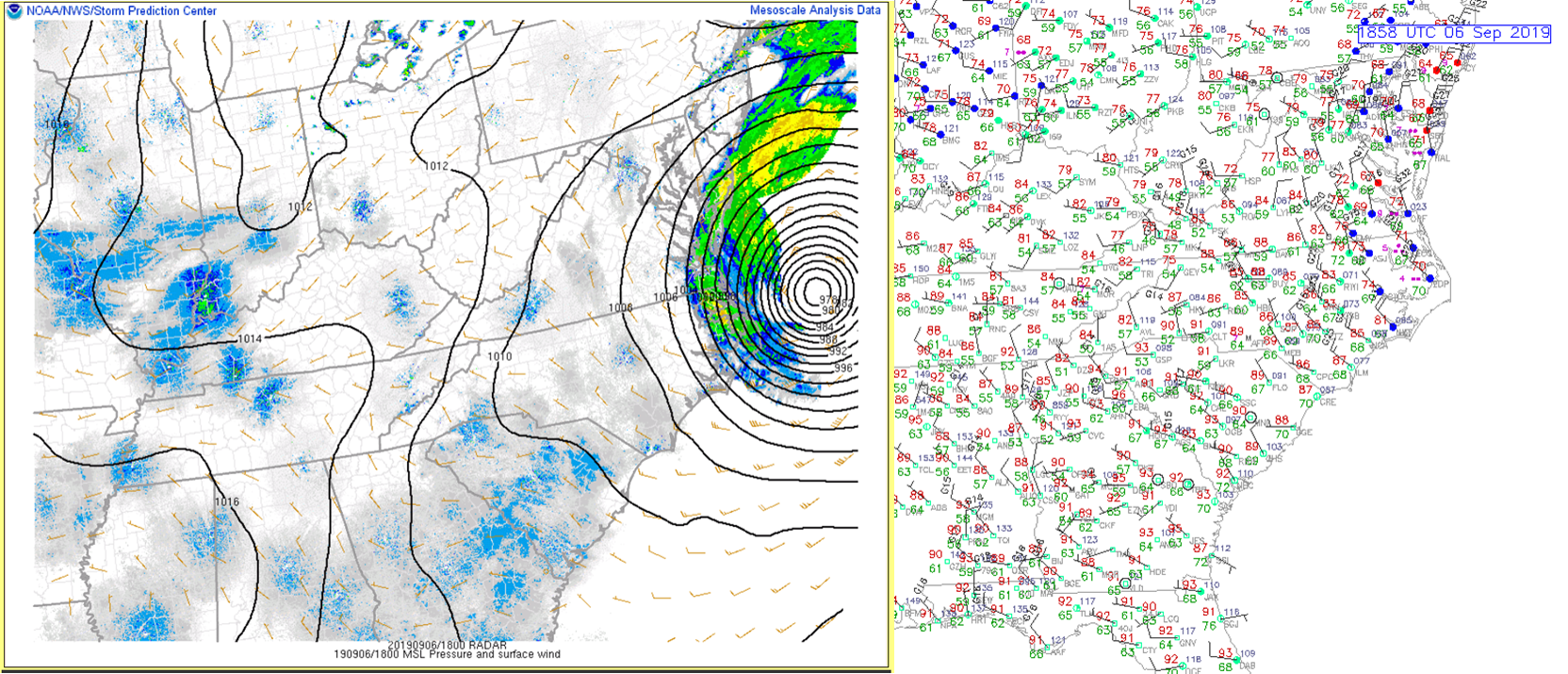 |
| 12z/8 AM Regional Surface Analysis | 15z/11 AM Regional Surface Analysis | 18z/2 PM Regional Surface Analysis |
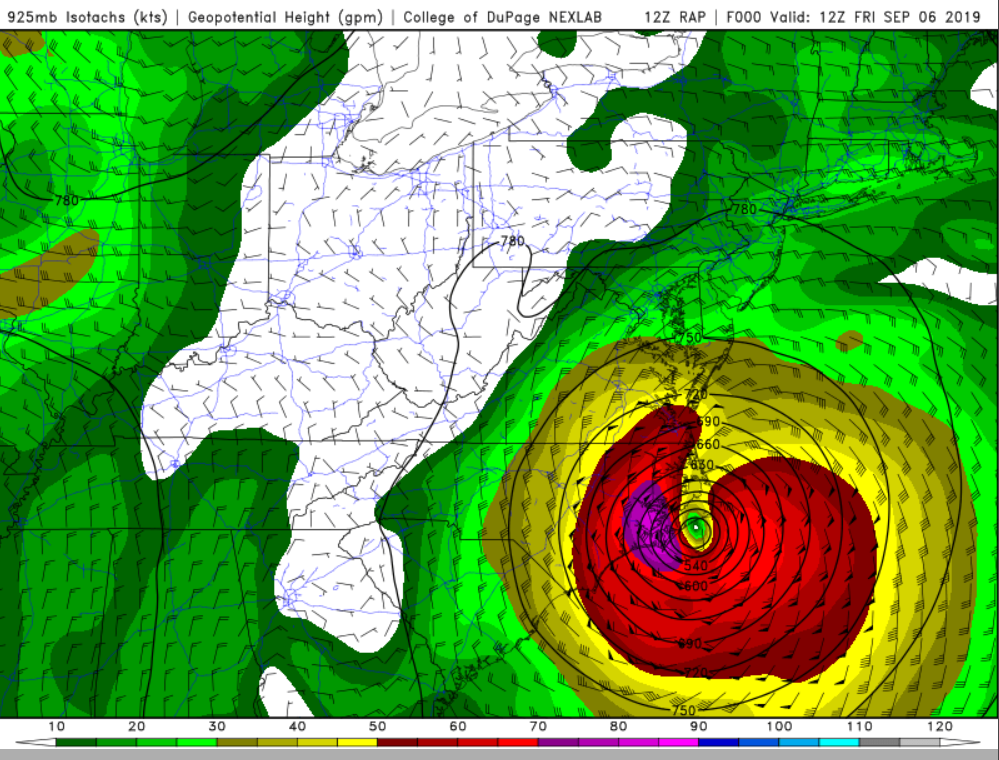 |
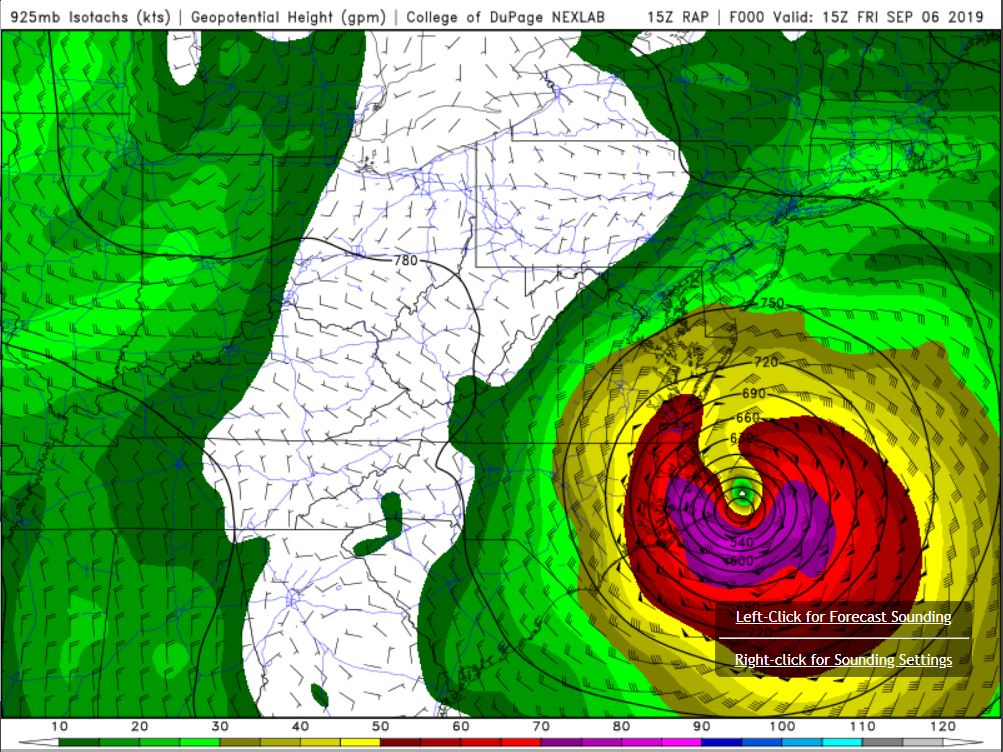 |
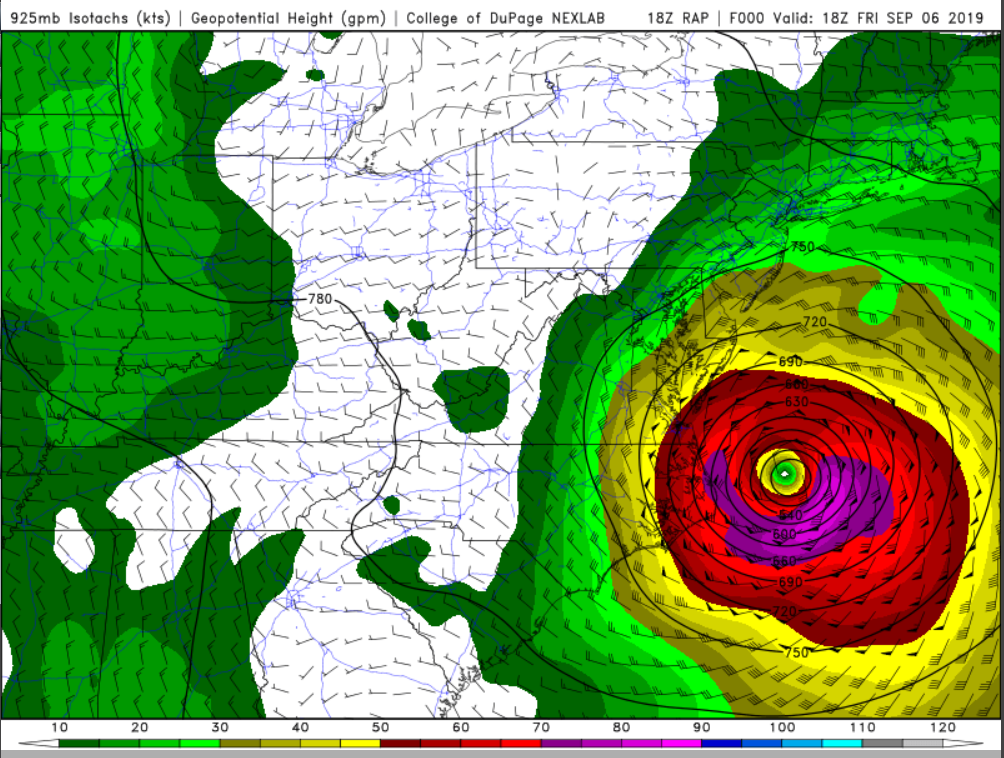 |
| 12z/8 AM RAP 925 mb Analysis | 15z/11 AM RAP 925 mb Analysis | 18z/2 PM RAP 925 mb Analysis |
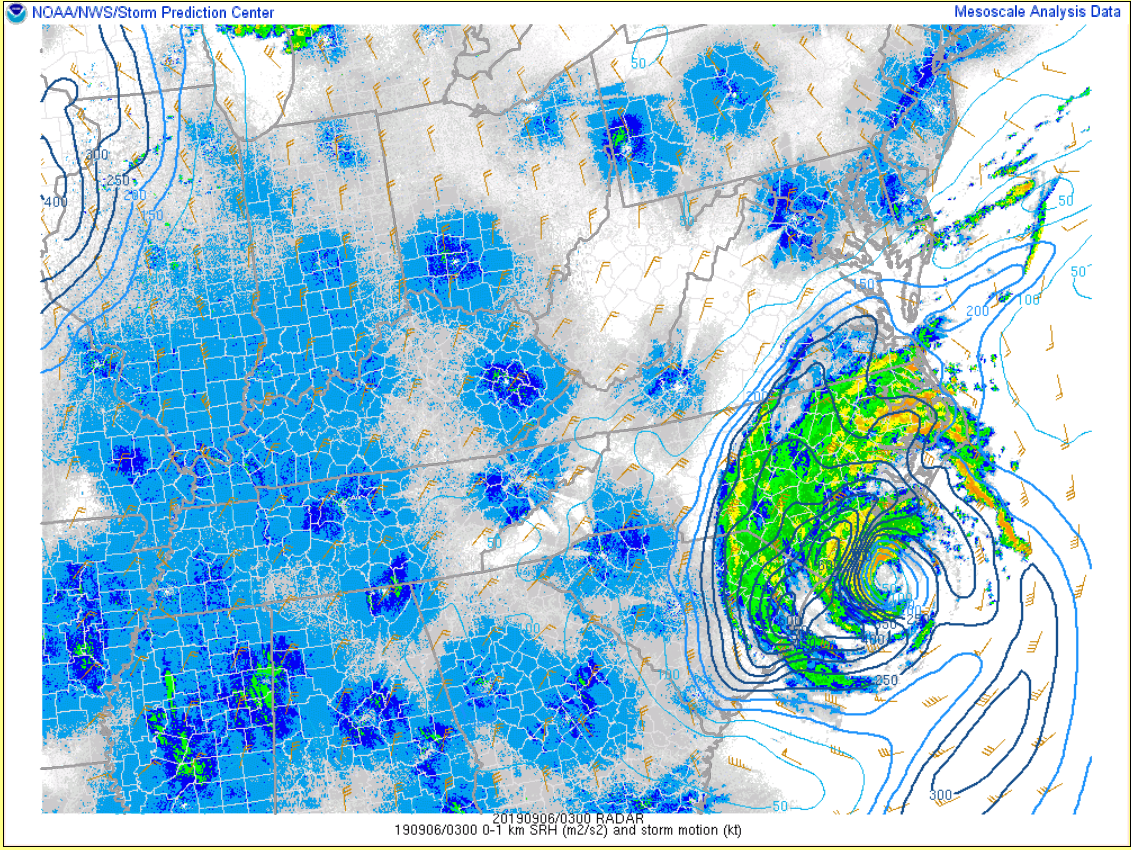 |
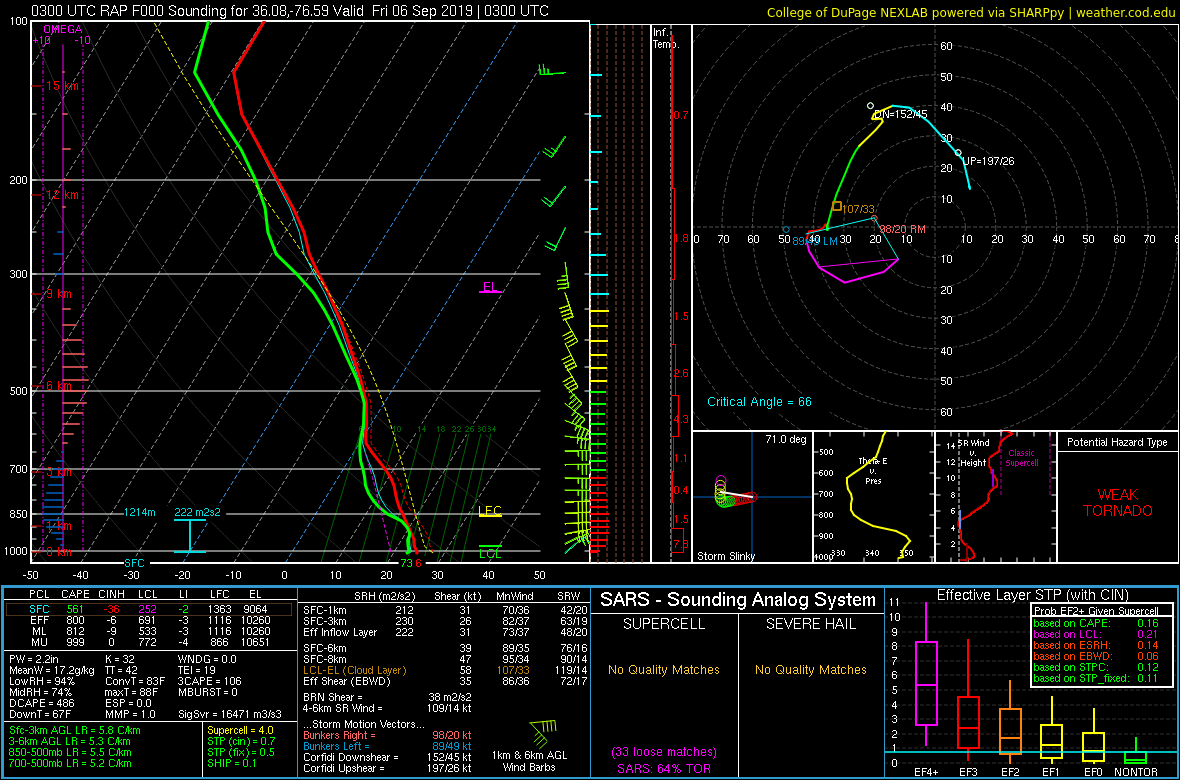 |
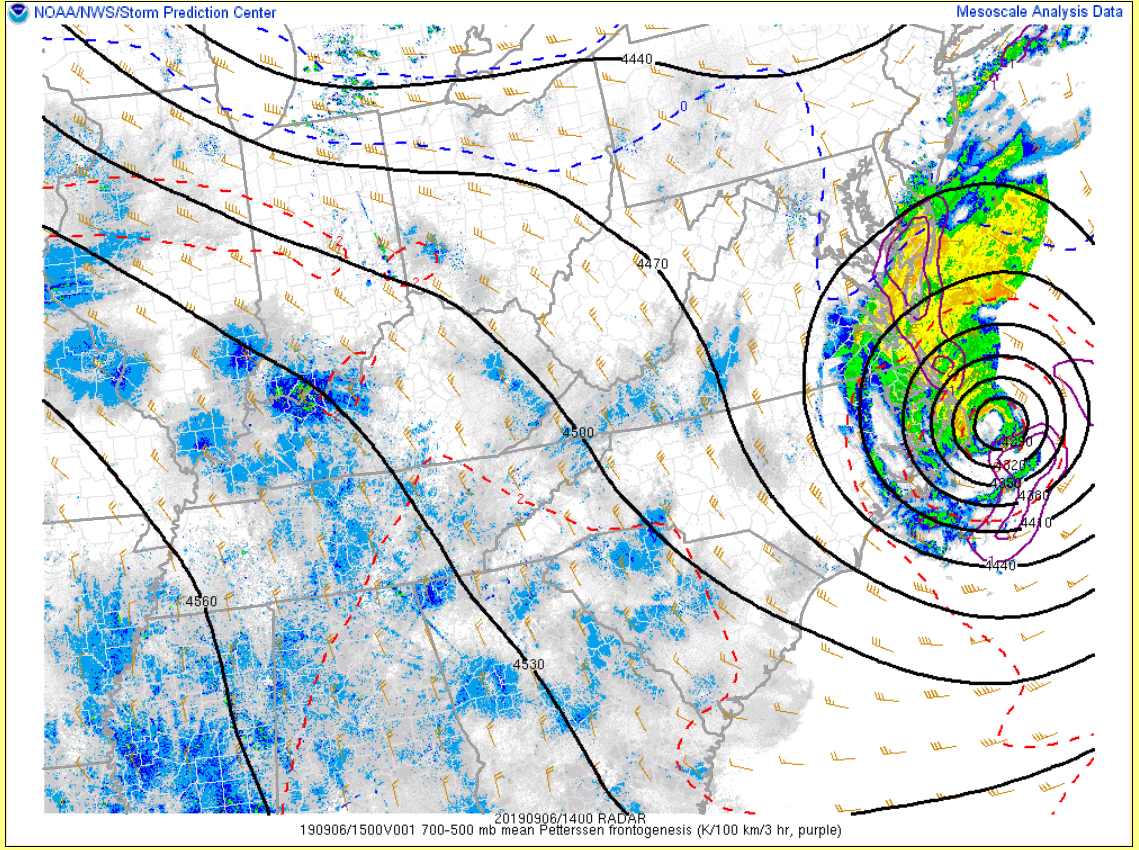 |
| 03z/11 PM 0-1 km Storm Relative Helicity | 03z/11 PM RAP Analysis Sounding from Edenton,NC | 14z/10 AM 700-500 mb Frontogenesis |
 |
Media use of NWS Web News Stories is encouraged! Please acknowledge the NWS as the source of any news information accessed from this site. |
 |